









If you’re looking for a beautiful garden to visit in October, there’s a selection to choose from in various parts of Devon, with lovely colourful autumn displays. The huge garden at Sherwood at Newton St Cyres, EX5 5BT near Crediton, is a new opening for the National Garden Scheme this year, with its final opening on Sunday 15th October from 10am until 5pm. There are 23 acres to explore, with two steep wooded valleys (so suitable footwear is advised). Admission £7.50, homemade teas will be available, visitors can bring picnics, dogs not allowed. Pre-booking is essential, go to www.ngs.org.uk for information.
The award-winning Marwood Hill Garden at Marwood, near Guineaford, Barnstaple EX31 4EB has long been a favourite north Devon garden among visitors and is a wonderful location in autumn, its 20 acres set in a tucked away valley, with three lakes and a great colourful display of trees and shrubs. It opens for the NGS on Friday 6th October from 10am until 4.30pm, admission £9.50, children £5. The garden tearoom has a selection of light refreshments, coaches are welcome, there’s partial wheelchair access, dogs allowed on short leads, and plants are on sale. For other opening times and information call on 01271342528 or go to www.marwoodhillgarden.co.uk
Dunley House, Bovey Tracey TQ13 9PW opens for the NGS on Sunday 15th October from 2pm until 5pm, nine acres set among mature oaks, sequoiadendrons and a huge liquidambar. Apart from the arboretum and woodland walks, there’s a walled garden with borders, fruit and vegetables, a large pond with new plantings, and a new enclosed garden with lily pond. Admission £6, children free, homemade teas, plants for sale, wheelchair access and dogs allowed on short leads. www.ngs.org.uk
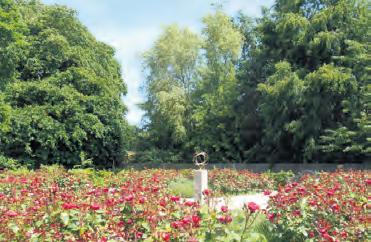


You can celebrate the bounty of autumn and the apple harvest at RHS Garden Rosemoor over the weekend of Saturday, 7th October and Sunday 8th October from 10am to 4pm on both days. At the Festival of Flavours, pick up ideas from cookery demos, expert talks and garden tours, and shop for treats in the food and craft market. Get in the festival mood with live music, campfire cooking and more. You can learn how to grow and cook your own ingredients with live cookery demonstrations over the weekend plus talks from local growers, book signings and expert advice from the Rosemoor gardening team There will also be daily tours around the Rosemoor vegetable plots.
On the Friday you can take along your pumpkin and enter the biggest pumpkin competition. There will also be a special display of heritage apples.
RHS Garden Rosemoor, Great Torrington Torrington EX38 8PH
Learning dry stone walling has become very fashionable and popular. Quince Honey Farm in South Molton is staging a morning workshop on Wednesday, 4th October from10am to 3pm to teach these traditional skills.
Dry stone walling is a positive and calming outdoors experience, and this workshop offers a great opportunity to learn a new skill, in the fresh air, surrounded by nature and wildlife. The course covers preparation of ground, quoins and repairs, and construction techniques for slopes, water edge hedge, standard wall and retention.
You can work at your own pace, with plenty of opportunity for discussion, then stand back and admire your craftsmanship and enjoy a cake and hot drink for your hard work! Price £65, booking is essential.
Quince Honey Farm, South Molton, Devon EX36 3RD
There’s family fun during the October half term in the Lorna Doone Valley near Lynton, made famous by R. D. Blackmore in his novel Lorna Doone, and now owned by the National Trust.
From crafting to nature discovery, families can have a fun day in the beautiful landscape on Wednesday 25th October. Running from 11am until 3pm, it’s a free event and booking is not needed, but normal National Trust admission applies. Activities may be outside if the weather is fine, but indoor seating is available.
Meet at The Buttery Cafe, with car parking behind the cafe at EX35 6NU. For more information call on 01598 741172 or go to nationaltrust.org.uk/lorna-doone-valley
For those wanting to see the evening wildlife of the Lorna Doone Valley there’s a Dark Skies wildlife walk on Friday 27th October. Join one of the escorted walks along the Doone Valley with the ranger team, and by using night vision cameras you will get to see what incredible evening wildlife calls the valley home.
Choose either the walk at 5pm which ends at 6.15pm or the 7pm walk which ends at 8.15pm. Tickets cost £10 for adults, £5 for children. Meet at the Buttery cafe EX35 6NU ten minutes before the start. Wear suitable clothing and bring a torch. The paths may be uneven, steep or grassy. Dogs are not allowed. For more information call 013442491895 or go to northdevon@nationaltrust.org.uk.

Exeter Cathedral hosts an Autumn Fair over the weekend of 3rd and 4th October with a variety of stalls in the magnificent Nave. The fair takes place form 6.30pm to 9pm on Tuesday, 3rd October and 10am to 3.30pm on Wednesday, 4th October.
Apart from an impressive line-up of local independent traders there will be music, food and drink and demonstrations by stonemasons Entrance to the Cathedral will be free during the fair.
Exeter Cathedral, The Cloisters, Exeter EX1 1HS
Buckland Abbey is joining in the celebrations of the autumn harvest with a harvest weekend in October. There will be picturesque harvest displays of produce grown at the Abbey and the chance to learn about the history of Buckland as a working estate. There will also be seasonal food and drink; Tudor cooking, pumpkin spotting in the Abbey and food bank collection. The events take place on Saturday and Sunday, 21st and 22nd October from 10 am to 4pm.
NT Buckland Abbey, Yelverton, Plymouth PL20 6EY
“No two gardens are the same. No two days in one garden are the same” - Hugh Johnson
“October is fresh faced April, beautifully aged to wisdom”
- Terry GuillmentsSherwood Festival of Flavours at RHS Garden Rosemoor Marwood Hill Garden Dunley House

Apple Days are back. Officially Apple Day throughout Devon this year is Saturday, 21st October but there are several events spread out across October to enjoy with a whole range of celebrations, with activities including lots of opportunities to take along your own apples and have them made into apple juice or if you are slightly more patient, cider.
APPLE VARIETIES GALORE AT BUCKLAND ABBEY
You can celebrate all things apple at Buckland Abbey over two weekends and learn about the apple varieties and the working estate of Buckland abbey, the two weekends are 7th and 8th October and then 22nd and 23rd October, 10am to 4pm.

Buckland Abbey, Yelverton, Plymouth PL20 6EY
APPLE SEASON IN CLOVELLY
It’s Apple season in Clovelly on Sunday, 22nd October with lots of apple crafts and activities.
A day out at this historical village is made even more magical with a host of activities for the whole family. There will be live music, apple bobbing, apple stamping and corn dolly-making. Crafts and activities take place in the Visitor Centre between 11am and 4pm - bring your apples for some creative arts.
Included is a Farmers’ market. There will be stalls that include pumpkins, locally ground vegetables and herbs. Plus the RNLI will be hosting an Apple Crumble competition!
APPLE JUICE DEMONSTRATIONS AT COCKINGTON COURT
Cockington Court’s Apple Day takes place on Sunday, 15th October between 11am and 4pm with free entry to the public.
A traditional apple press on the front lawn will be the star attraction with demonstrators turning apples into juice and describing how to transform the juice into delicious homemade scrumpy. Visitors are welcome to use apples gathered from Cockington Court’s orchard or can bring their own apples for pressing, for a small donation.
There are plenty of activities for the whole family to enjoy including: arts and crafts, live music and carriage rides (must be pre-booked), and many market stalls selling food, drinks and crafts. For those wanting a bite to eat, hot and cold food will be available all day from the Seven Dials Café and a range of local cider and beer will be on offer.
Cockington Court, Cockington Lane, Torquay TQ2 6XA
Apple bobbing, juicing, tasting and more apple varieties are booked in on Thursday 26th October from 10am to 12pm at Hexham’s Cross Farm.
The Apricot Centre, Huxhams Crtoss farm, Rattery Rd, Dartington TQ9 6AA
Community garden projects in Devon are setting the highest standards says a new Government report. Three gardening schemes in South Molton, Bideford and Barnstable are three which have been highlighted in Devon as an example of how communities can be improved with horticulture. The report is being prepared to encourage communities in urban areas to make better use of ‘spare land’ for flowers and vegetables.
Little Green Town is a community project in Bideford, to create a town that is full of plants, edible crops free for picking, flowers for wildlife and ultimately share the joys of gardening. Volunteers have worked hard to transform a large bed in the Bridge Street Car Park into a community herb garden, full of chives, sage, rosemary,
If your gardening club or association is getting back into full swing after the restrictions of the past couple of years be sure to let Country Gardener know. Send your club meetings and outings details to timeoff@countrygardener.co.uk
4TH
Brixham Horticultural Society MONTHLY MEETING
Details on 01803 842121
Broadhembury Gardening Club
‘UNUSUAL HERBACEOUS PERENNIALS’ - PETER CANTRILL
Broadhembury Memorial Hall 7.30 Contact 07719934173
5TH
South Devon Alpine Garden Society
‘AUSTRALIA: WILD FLOWERS AND WALLABIES’- HILARY LITTLE
7TH
Devon Group of the Hardy Plant Society
‘THE DRY GARDEN’ - CHRISTOPHER BAILES
Longdown Village Hall, Exeter
11TH
Ogwell Garden Society
‘PRUNING POPULAR SHRUBS’ - TIM ELLIS
12TH
Seaton Garden Club
‘FORDE ABBEY PLANTS’ - PAUL BYGRAVE
Details on 01297 22869
16TH
Meavy Garden Society
‘DEVON’S ORCHARDS: HOW DEVON
TOOK TO CIDER’ - MICHAEL GEE
Details on 01822 852672
17TH
Bickleigh, Roborough & District Garden Society
AGM
18TH
Torquay & District Garden Club
‘DAHLIAS’ - JON WHEATLEY
email: nickibaker222@gmail.com
24TH

Crediton Garden Club
‘HOSTAS’ - PETER SAVAGE
26TH
Budleigh Salterton Garden Club
‘FRUIT FOR SMALL GARDENS’ - SALLY NEX
Details on 01395 445840
Exmouth Garden Club
‘HELP! I’VE BEEN GIVEN AN ORCHID.
WHAT DO I DO NOW?’ - CLIVE LLOYD
Details on 07956 581314
28TH
Dawlish Garden Society
‘REFLECTIONS ON COLOUR’ - SUE MINTER
Details on 07749 395584
30TH
Woolwell Horticultural Group
AGM & ILLUSTRATED TALK, ‘PROTEACEAE’ - SAUL WALKER
Details on 01752 776230 (evenings)
If you would like a last resting place in beautiful countryside overlooking Dartmoor. Phone 01647 24382 and speak to Julie or Martin Chatfield

www.crosswayswoodlandburials.co.uk

thyme and more. There are also crops growing in the Riverbank car park, beds of strawberries, banks of rhubarb and tomatoes to name a few, are now brightening up the previously empty beds.
In South Molton, they’ve managed to get community gardening off to a fine art. The town won the prestigious Southwest in Bloom Gold award. Floral fanfares don’t come much greater and ever since this victory, there has been a campaign of colour to keep South Molton looking fabulous.
Barnstaple is also is looking well-loved and beautiful these days, thanks to its proactive In Bloom team.
The community effort, involving several partnerships between the local authority, businesses and groups has helped to make Barnstaple a cleaner, greener place to live and visit. Projects have included creating a spectacular wildflower spiral in The Square, full of pollinator-friendly plants.
Volunteers have also been helping to tidy up and beautify the beds in the Strand, as well as improve the general appearance of the town’s streets. There’s even a ‘Monday night hit squad’, which carries out litter picking, weeding and even small painting jobs in the places in need of a bit of love and attention.
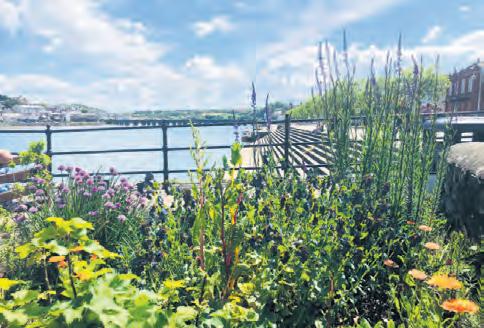
to the public market, from which they had been missing for 16 years. Apple Day was intended to be both a celebration and a demonstration of the variety we are in danger of losing, not simply in apples, but in ecology and culture too. It has also played a part in raising awareness in the provenance and traceability of food.
Common Ground has used the apple as a symbol of the physical, cultural and genetic diversity we should not let slip away. In linking apples with their place of origin, they hope that orchards will be recognized and conserved for their contribution to local distinctiveness, including the rich diversity of wildlife they support.
Apple Days are an autumn celebration of our local fruit heritage. They have been growing in number since Common Ground held the first event in Covent Garden in 1990 to raise awareness of the threats to UK orchards and their diverse fruits.
Apple Days now come in all shapes and sizes, from small village events to gatherings of thousands.
The apple is a firm favourite in our gardens and kitchens, but peel back its humble exterior and you'll realise that the apple has a huge part to play in our culture and the ecology around us.
Hence Apple Days which are now an important part on pour autumn calendar.
Apple Days and Apple Weekends are with us again, ready to celebrate the wonders of apples and the diversity of the orchards and landscapes which produce them.
Officially- the formal day for Apple Day this year is on Saturday , 21 October, but events all over the south and south west are being fitted into the calendar to help people produce apples juice from their own apples, help understand and identify different apple varieties and generally to share a passion for the apple which has long and vivid south west history.
Celebrated on or around the 21 October every year, the 'apple weekend' has become increasingly popular, encouraging people to organise their own events and bring together families, schools and communities.

Apple days are certainly worth our continued support .After being like most social events affected by Covid two or three years ago extra effort has gone into the 2023
Apple Day events
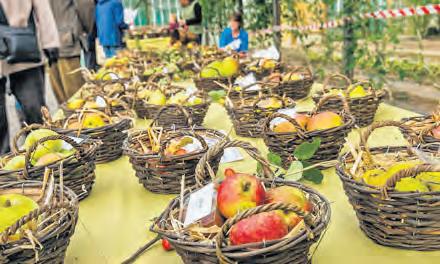
Launched in 1990 by Common Ground, a charity based in Dorset, England. The event's name is partially owed to the fact that the day marked the return of apples
Each year alongside tasting, juicing, pruning and crafting, an imaginative array of games and creative activities have flourished ranging from simple apple printing to mummers’ apple plays songs and poetry evenings. Inevitable the most popular aspect of any Apply Day is the display, tasting and buying of the many hundreds of varieties of apples and the presence of an expert to help with the identification of which variety gardeners are growing Sue Clifford from Common Ground said, "Apple Day is not a marketing device- the apple and the orchard are symbols of hope and history. They demonstrate how we can have our trees , bees, bats butterflies, birds and badgers whilst growing good fruit to eat and drink.
"It’s a day to recognise the wealth and variety of apples available in the UK."

The hope that Apple Day could be a national holiday is being given new impetus this year. Common Ground, the Dorset based charity at the forefront of community conservation says there is a fresh impetus for the campaign
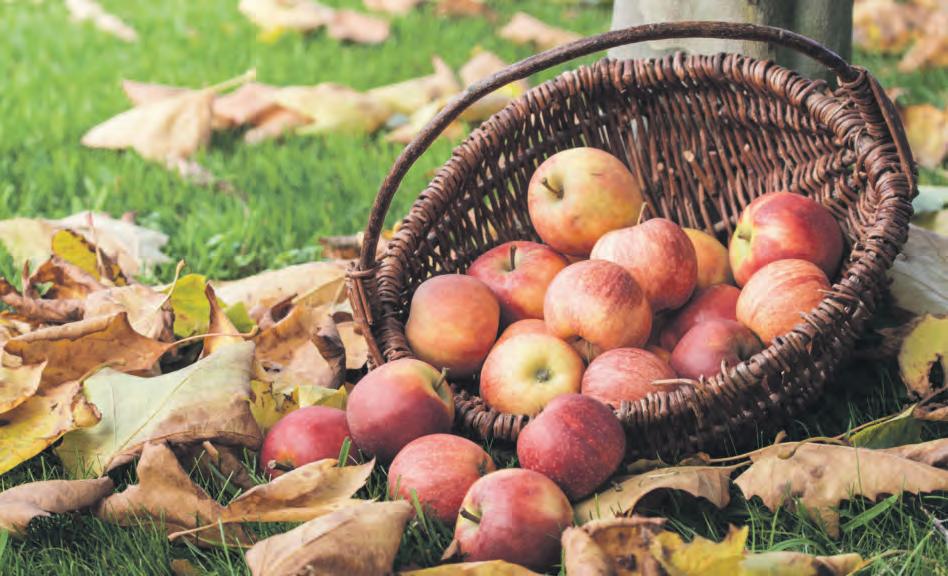
“We would still like Apple Day to become the autumn holiday in Britain. Apple Day is now an integral part of the calendar of many villages, local authorities and city markets. It is a focus for activities organised by the Women’s Institute, National Trust properties, Wildlife Trusts, museums and galleries, horticultural societies, shops and restaurants as well as for schools, colleges and environmental study centres.The first Apple Day celebrations, in the old Apple Market in London’s Covent Garden, brought fruit to the market after 16 years’ absence
"We will never know just how many people came to that first celebration – it was certainly thousands and even now we meet people who effuse about it as a memorable event. Many wanted it to be repeated, but our intention was to spread the idea far and
wide, encouraging people to celebrate Apple Day for themselves in their own city, village, parish, allotment or garden orchard.
"Over the next few years, the number of events being organised around the country grew from more than 60 in 1991 to 300 by 1997 and over 600 in 1999, some attracting thousands of people. It has been one impetus behind the developing network of farmers’ markets and is helping people everywhere to discover they are not alone in valuing the links between food and the land, between natural resource use and the impact we have on nature."
MATFORD TRADE NURSERY OPEN TO PUBLIC



palms | olive trees | bananas | exotic fruit


trees | hedging & shrubs | pleached trees
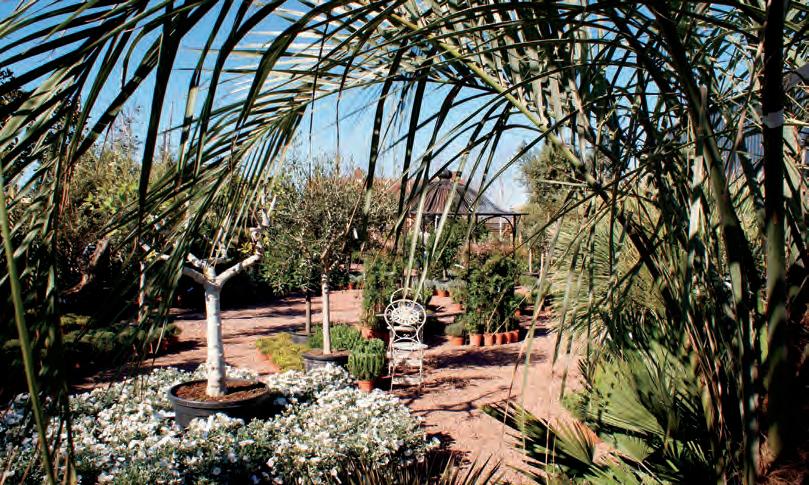

climbers | tree ferns | succulents & cacti
bamboos | herbs & grasses | pots
Offering delivery, planting services and garden design.
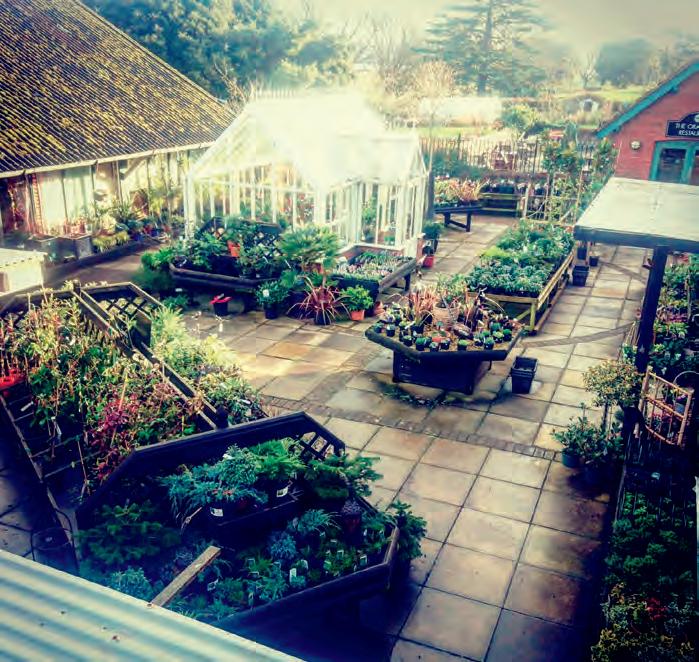
perennials | bedding plants | roses | shrubs




climbers | fruit & vegetable plants | herbs
indoor plants | succulents & cacti | seeds
gardening tools | pots | gifts
Offering hanging basket and container planting services.

For recipe ideas and recycling tips visit recycledevon.org/pumpkin-rescue


An autumn feel for many of the queries from Country Gardener readers this month involving harvesting, pruning and autumn diseases. If you need any help with a gardening problem email us at editorial@countrygardener.co,uk or write to us at Mount House, Halse, Taunton Somerset TA4 3AD
I have a lovely Curio rowleyanus ( ‘string of pearls’ plant) in my kitchen and after a couple of years of falling in love with it, it now seems to be dying. I am desperate to see what I can do to save it but all I read is that I should expect it to be a difficult plant to care for.
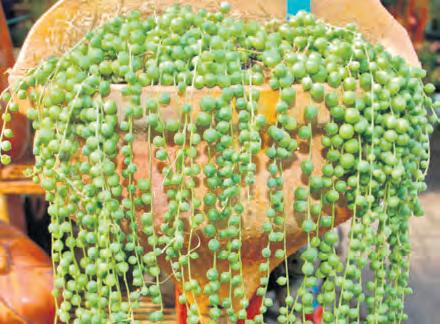 Jane Anderson Plymouth
Jane Anderson Plymouth
Caring for this succulent is not an easy task and it can be the most demanding of house plants. It is however a beautiful thing to have in your house. In its native South Africa, the plant spreads out its roots into crevices where it can. The root system is fine, shallow and fibrous. Plant it in moisture retentive houseplant potting mix with little drainage and it won’t be long before the plant shrivels, signalling the onset of root rot.
Repotting into specialist cactus and succulent substrate in a shallow terracotta pot will certainly help. The plant’s curious globular shaped leaves have evolved to minimise water loss. Water sparingly in winter and only when the leaves start to deflate and give it plenty of sunshine.
I am a new gardener and discovered your magazine and love it. My love for gardening is being severely tested by my inability to control weeds which takes up so much time compared the nicer tasks of growing lovely flowers and vegetables.
Daphne Porter Bude
The adage about little and often is appropriate for weeding. However, the key to less weeds in your garden is also to make sure they have nowhere to grow. Start planting beds more densely so that space is colonised rapidly by cultivated plants rather than weeds – if there’s no bare soil it’s more difficult for weeds to gain a foothold. If you’re planting a new border, make sure the ground is cleared properly at the outset. Thick perennial weed roots such as ground elder and bindweed will regrow from tiny bits that break off. Mulching is also key to controlling weeds and applying a five cms covering will do wonders for weed control. Where perennial weeds are particularly difficult to get rid of, spread a weed-suppressing membrane over the entire area and plant through holes cut into it before laying a mulch of bark chips on top.
My rose arch has had its worst summer for several years. I’ve been struggling to fight off black spot and mildew and they seem to influence the blooms and how long they were in flower for. The rose arch has plants that are about 12 years old. Do they need replacing?
Vera Davies Martock
Roses should last longer than that so the problem is probably elsewhere.
Mildew and black spot are fungal diseases which mainly strike when the plants are under stress – usually on account of a lack of food and water. Climbers are especially prone to attack which can spread within a confined area like a rose walk. Make sure that a good rose plant food and water are in good supply and mulch the ground around the plants with well-rotted manure, compost or chipped bark to retain moisture in dry spells. Keep the whole area free of weeds and grasses. If your rose arch varieties are prone to these diseases, swap them for leathery-leaved, disease resistant varieties, which are less likely to be attacked.
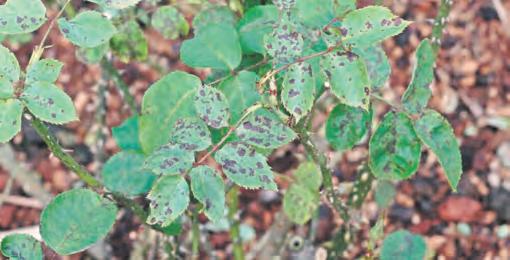
I followed the advice in one of your recent magazines about trying to grow the perfect courgettes. Something still managed to go wrong, and I enclose a picture of what happened to several of my plants. It has been disappointing.
Andy Wiliamson Liss
We all know how fast courgettes can grow. Watering is the likely cause of any strange, shaped courgettes. Courgettes develop very rapidly, and they require a constant supply of water. Erratic watering tends to produce some very odd, shaped courgettes; however, it is not uncommon for there to be perfectly normal shaped courgettes found on the same plant. The trick is during periods of rapid growth to make sure your watering isn’t stop/ start but regular.

I have a lovely hydrangea up against a south a facing wall and it has been growing well. This summer is has started to look as if it is struggling with blooms fading quickly and lots of dead wood. What can I do to revive it?
Ava French Swindon
Hydrangeas respond really well to a proper pruning and it may be your plant is calling out for just this. Hydrangeas flower from mid to late summer on the previous year’s growth. Mophead and lacecap hydrangeas will bloom satisfactorily with little attention, but regular pruning encourages new, vigorous growth that can produce a better display and can counter any fading blooms. Likewise, other species, including the climbing hydrangea, will certainly benefit from a trim. The climbing hydrangea should have overlong shoots cut back immediately after flowering. Most flowers appear towards the top of the plant, so try to leave as much of this un-pruned as possible. Also remove any weak, straggly stems. Cut out any stems that trail onto the ground.
Many of my vegetables this summer have started to bolt much earlier than normal. I have not been over feeding or treating them any differently.
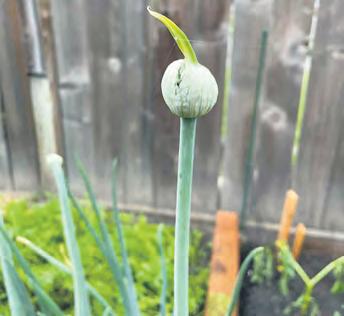
Robin
Williamson SomertonBolting occurs in when the plant switches from plant production to seed production and the effect can be quite dramatic. A plant will normally do this if there has been extreme temperatures and it may be the hot spell in May and June in the south west affected your plants. If such circumstances happen again try and keep regular watering and make sure you mulch the plant well so that moisture is retained.
It’s early September and for some reason my tomatoes growing in the greenhouse don’t seem to be ripening.
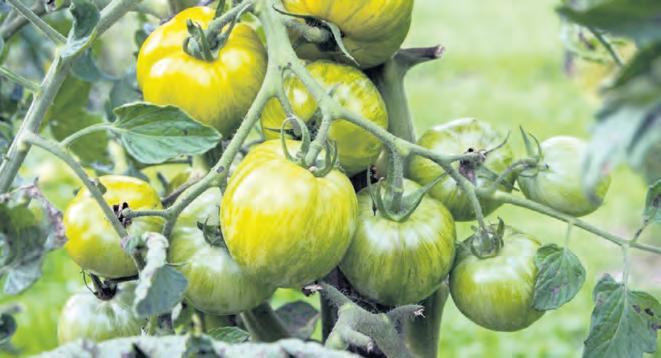
Steven Harrison Taunton
It may be too hot or too cold in the greenhouse. Harvest the fruit as soon as it starts to colour and take them inside to finish ripening. It’s a much quicker process. You can also remove excess stems and any suckers or blossoms which at this stage won’t turn into fruit, this will concentrate things on the fruit which has already formed.
Pumpkins are fun and easy to grow in any vegetable garden. They can be used at Halloween, autumn decorations, or stored for cooking and baking. However you use your homegrown pumpkins, it’s important to harvest the fruits at exactly the right time
Recognising when a pumpkin is ripe is an important skill for gardeners to learn, particularly those who want to store their pumpkins for cold season cooking and baking. A pumpkin harvested immature generally rots within a few weeks, if not sooner. On the other hand, pumpkins left in the garden too long, especially if they’re exposed to frost and cold temperatures, also rot.
I am trying in my half an acre Somerset garden to adopt an organic approach. I am recently retired and have more time to be out in the garden and try and make it work. The really discouraging thing this summer has been the huge number of insects which have been all over the garden and I have been struggling to cope.
Maurice Peteries Dawlish
It isn’t easy especially in the early stages of making such a switch. You need to look at ways of limiting insect attacks – including growing a wide range of plants, mixing them up and avoiding plants that are martyrs to greenfly or whitefly. Encourage birds, many of which eat insects, to come into your garden. Ladybirds, lacewings, hoverflies and wasps also eat aphids, and can be encouraged in by planting the right sort of pollinating flowers. Squirt off pests with a powerful jet from a hose as soon as you see them forming. Plants that are well grown, well fed and watered, are more capable of shrugging off attack than feeble ones that are struggling.

My new garden pond has been full of water which is the colour of pea soup and I’ve struggled to get it clear despite lots of work and advice. My friend says that it’s firstyear pond syndrome!
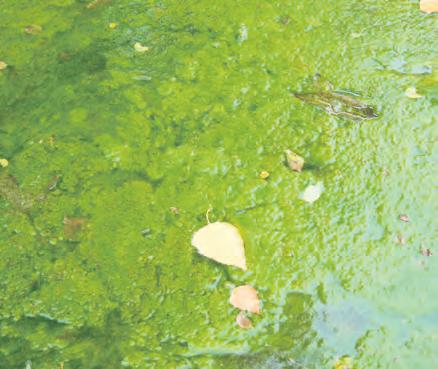
Mark Foster
Budleigh Salterton
Crystal-clear water is what you want and should be able to achieve from day one. Remember that new ponds will always turn green, but the water should clear once that mystical stage known as ‘a balance’ has been achieved. This ‘balance’ is the result of sufficient submerged oxygenating plants being given a chance to work their magic, and some of the pool’s surface being covered by water lily leaves or other floating aquatics, providing shade and absorbing nutrients. Smaller ponds will heat up quickly and blanket weed will be a constant problem. The ideal depth at the centre is 60-100cm so that temperatures are more constant. Blanket weed can be removed by twisting it round a garden cane and hauling it out.
Pumpkins are a warm season vegetable related to cucumbers and melons and need a long growing season to go from seed to harvest. Each variety has a ‘days to maturity’ listed on the seed packet that tells you how much time it needs to go from seed to harvest.
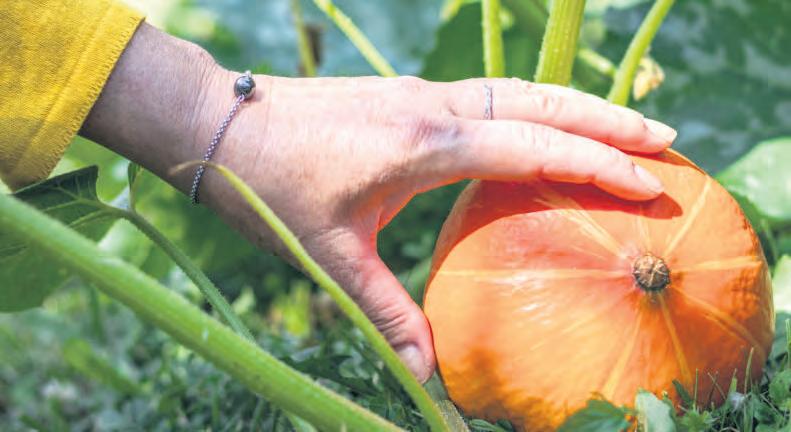
Most pumpkins are harvested in September or October. There are four signs to look for to determine if a pumpkin is ripe and ready.
1) MATURITY
Every pumpkin variety has a specific ‘days to maturity’ listed on the seed packet. This is the time required to go from seed to harvest. Most pumpkins need somewhere between 90 to 120 days to mature, although giant pumpkins need up to 150 days.
2) COLOUR
Fruit colour is the most obvious sign that pumpkins are ready to harvest. When the fruits have turned their mature colour of orange, white, red, blue, or yellow it’s time to take a closer look to gauge ripeness.
3) RIND
As pumpkins and winter squash, mature, the skin hardens and becomes shiny. This is where the fingernail test comes in handy. The rind of a fully mature pumpkin is very hard to pierce with a fingernail. Choose a spot on the back of the pumpkin (where a small mark won’t visible if it’s to be displayed) and push your fingernail against the rind. If it’s very firm, it’s likely ripe and ready to harvest. If your fingernail sinks into the flesh, it’s underripe.
4) STEM AND SOUND
Sound? Yes sound! A fully ripe pumpkin has a hollow sound when you thump it with your hand. You should also examine the stem. The stem of pumpkins turns from green to brown as the fruits mature. A woody stem is a sign that it’s ready to pick.
It’s not unusual to have to harvest pumpkins early, and often before they’re fully ripe. It’s not ideal, but that doesn’t mean your still-green or half-green pumpkins won’t turn orange. If a freeze is in the forecast, it’s better to harvest pumpkins than leave them in the garden where they may be damaged and prone to rotting.
After you’ve cut a green pumpkin from the stem, bring it indoors to protect it from cold temperatures. It should be a warm, well-ventilated space like a shed, garage, greenhouse, root cellar, or inside your home. Once the weather improves, place the pumpkin outdoors in full sun. Rotate it every few days so all the green parts can mature to orange.
It’s best to harvest pumpkins on a sunny, dry day. After spending months growing pumpkins, you’ll want to make sure you harvest them properly so grab a sharp knife. Don’t try and tug or pull pumpkins from the vine as this can damage fruits still maturing on the plant. Or it can cause the stem of your pumpkin to break off. A pumpkin without a stem, also called a handle, typically does not store well.
Using your hand pruners or knife, cut the pumpkin from the vine, leaving a good-sized stem. I like to cut up to six inches of stem, which can be trimmed later if necessary.
Fully cured pumpkins can be stored for four months. The ideal storage site offers a temperature range of 50° to 60°F (10° to 15°C) and a humidity of 50 to 70per-cent Line them up in a single layer on the floor or on shelving, making sure they don’t touch. Check them every week or two to make sure none have begun to rot.














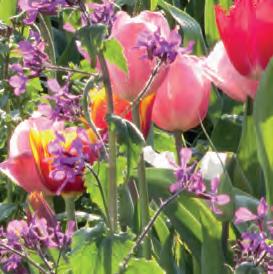


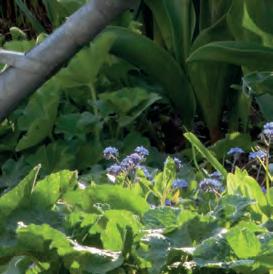







Liquid plant food is full of nutrients that can help your plants thrive. Why not try making your own liquid feed at home?
plants. All you need is a bucket with a lid and a watering can to apply it. Soft green leafy material is most reliable, but you can use any weeds or prunings.
Comfrey and nettles are two of the best plants to use due to their higher nutrient content. Homemade mixtures can be variable so you should avoid overdosing by diluting the product one part fertiliser to ten parts clean water.
Making your own home-made fertiliser is an eco-friendly way to save money. It is also easy and very effective. Any plant material when left to decay will release stored nutrients. however by steeping the material in water, those nutrients are leached directly into liquid, taking on a soluble form that’s easily available to other
Most of the plants in our gardens will benefit from a liquid feed, including flowers and food produce.Houseplants can have slightly different nutritional needs, but they will still benefit from your homemade plant food. You can use your liquid plant food once every few weeks while your plants are actively growing.
There are a few plants that can be used to make liquid plant food. Here, we look at the three most common.
1. COMFREY
Comfrey has the highest level of nutrition. If you grow it in your garden, it will provide endless amounts of feed over many years of growth.Comfrey is rich in potassium and good for fruit, vegetables and plants that have big shows of flowers.
2. NETTLE
Nettle is high in nitrogen and good for herbs, shrubs and leaf vegetables, particularly brassicas.
The challenge may be collecting it, as many people don’t like to cultivate nettles in their own gardens. Don’t pick nettles from wildlife or nature reserves, as this may disturb wildlife habitats. It’s a good idea to check with the landowner if you are thinking of picking from another public or private space.
With dandelions, you make the feed using the root as well as the stem and leaves. This creates more micronutrients such as magnesium and iron, which are important in plant growth.
As with nettles, not everyone likes cultivating dandelions in their garden. Perhaps you will come around to growing them if they are a source of homemade plant food!
Trees and shrubs rarely need food. Rather than feeding the entire garden, focus on fast growing, leafy bedding plants and vegetables
THREE EASY STEPS:
• You will need plant material (e.g. comfrey, nettles or dandelions): a bucket or large container with cover; gardening gloves;water (rainwater if possible).

• Harvest 1kg of comfrey leaves.
• Roughly chop the leaves with 15 litres of water and leave to steep for six weeks.
• Discard the leaves.
• Use the liquid neat around your plants to boost them.
Banana peel is such a treat for plants, especially roses. They’re packed with potassium, phosphorus and calcium. You can make a banana peel fertiliser in a few different ways.
Soak two to three banana skins in roughly 600ml of water for a few days. The minerals will leach into the water, which you can then use as it is for your plants, with no need to dilute. Give the soaked peels to your worms or put it in the compost.
Blitz your peels together with a cup of water to make a banana peel slurry. Pour this on the base of your roses and they’ll love you for it.Spoiled, old bananas can be blitzed into liquid too and poured around your plants. Try it in your vegetable garden.

Over the last five years I’ve been using peat-free compost in increasingly large quantities each year to grow every type of vegetable and most ornamental plants available to gardeners, including several acid loving plants in ericaceous peat-free compost.
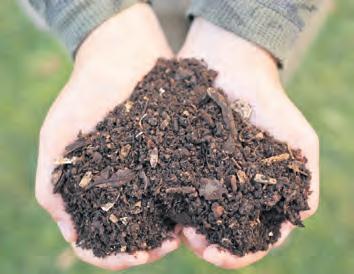
even with a batch of compost with lower nutrient levels I’ve been able to adapt and adjust the fertilising accordingly. I’ve shown that I’ve been able to spot temperature hampering growth and moving plants to warmer spots to account for it.
My point is, this is gardening. You can do it too.
I even conducted a peat vs peat-free comparison trial on a number of different crops last year to prove peat-free can grow as well as peat, which was as expected, a success.
Yet people still say to me “peatfree is variable”; “peat-free dries out too quickly”, “my seeds didn’t germinate”, “I must have a bad batch”, “it doesn’t have enough nutrients”.
Gardening is full of problems with plants and setbacks. That’s what happens when dealing with living things. No matter how many years’ experience or how good you are at growing, certain things are out of your control. There are many things we can get wrong, from watering to feeding, temperature, timing, bad seeds, old seeds, incorrect sowing depths, light levels and many more.
I get plenty wrong.
Sure, some peat-free compost brands are better than others, in the same way peat composts have always had the good and bad brands. Sure, you might get a bad batch; I received a couple of bags this year of old compost with noticeably less nutrients in them. Sure, peat-free compost generally retains more moisture making early sowings of seedlings more prone to cold. So what?
I’ve shown that I have been capable of trying out different brands to find those I trust. I’ve shown that

When people on our allotment talk to me about their plants growing in peat-free compost it has always been problems with one or two of the following: under or over watering, lack of nutrients, temperature, time of sowing, quality or viability of seed. Peat-free compost can be a little clumpy and it needs aeration. It is easy to rectify this. It can be mixed with vermiculite to give it a nice open structure and aeration. Watch out for peat-free compost being dry on the top as quite often the bulk underneath is moist. Use your finger to test the top two or three inches.
However, when making the switch, it’s always worth doing your research and checking that your chosen mixture will suit whatever you need to use it for – whether that’s mulching, seed-sowing, or planting up your containers. You may also need to adjust your usual approach somewhat. coir-based composts often look dry on the surface when they are still wet. This can lead to problems with overwatering. The quality of peatfree compost has greatly improved over the years. So even if you’ve tried them in the past and had poor results, it’s well worth trying again – especially when you factor in how much better for the environment they are.
Until quite recently, peat-compost was a go-to choice for many gardeners who were short on time and needed to give their flowerbeds a boost. It’s moisture retentive and, as it’s made from partially rotted down plants, is high in nutrients. But nowadays thankfully, more and more people are aware of the damage that harvesting peat causes to the environment and are opting to go peat-free instead.
And once you know all the facts about peat, it’s likely you will, too.
Introducing

Conservatory Insulations C.H.R.I.S. ® system ensures the very best performance for your conservatory, giving you a room to use all year round, whatever the weather!




Having already installed over 30,000 systems to date, you can rest assured in the knowledge the C.H.R.I.S ® system is the very best available on the market today and is the only system specifically designed for conservatories.


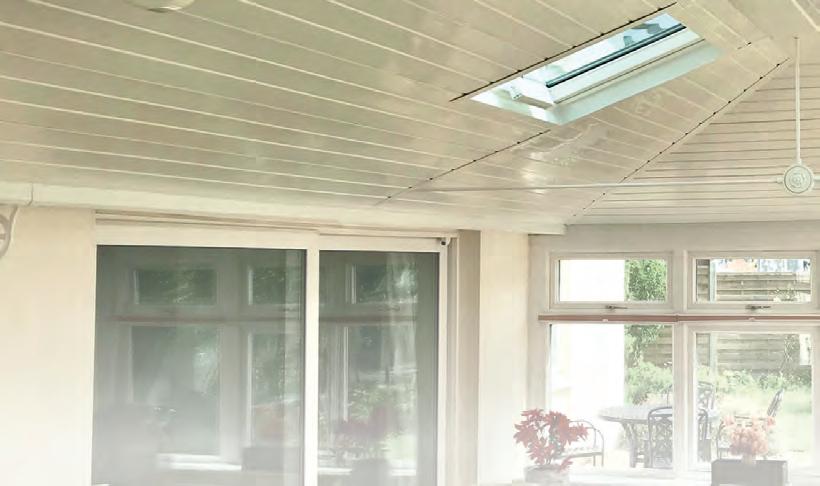
The C.H.R.I.S ® system is a cost-e ective solution which insulates your conservatory for a fraction of the cost of a new tiled roof. For complete peace of mind, we o er a 10 year insurance backed guarantee.

Topiary has been used historically in many different European gardening styles, from early Roman gardens through to modern day. From box balls to yew ‘peacocks’, it is so versatile and striking that many gardeners are inspired to create their own piece of living architecture.
Topiary is one of the most impressive forms of gardening there is. The art form of crafting trees and shrubs into a particular silhouette with such attention to detail is stunning to say the least.
If you think it’s worth trying your own topiary, you may be daunted by the amount of effort required to perfect the new craft.
Every skill requires some patience and perseverance when starting out. But this one is well worth getting right. Starting small is the best way forward to home your skills. What you need is a plant which is easy to grow and even easier to prune to get you accustomed to topiary in general. The faster your tree grows the more opportunities you will get to develop that perfect shape. By keeping it small you are also reducing potential mistakes. When pruning your plant what you don’t want to happen is branches falling off, breaking and damaging a shape. Taking care of your plants isn’t just down to aestheticsyou must ensure they are growing strong and healthy. "Clipped trees introduced singly, in pairs or in groups, provide a certain atmosphere in a garden," wrote Nathaniel Lloyd, who created the impressive topiary at Great Dixter in East Sussex in the UK. This ‘atmosphere’ relates to character, but also to structure.
The Romans clipped evergreens (such as myrtle) into geometric and animal shapes, or cut them to resemble mini versions of huge trees seen in the wild, in order to create a microcosm landscape (the word topiary comes from the Greek topion, meaning landscape). In Tudor England, flamboyant and geometric topiary was all the rage; it fell out of fashion in the 18th century, before having a revival in the Edwardian era, when many gardens had topiary pieces, such as teapots or peacocks.
For basic, compact shapes, a good pair of secateurs and shears will suffice. But if you’re going to create a lot of topiary, including intricate pieces, it’s worth investing in a decent pair of one-handed topiary clippers, which allow a lot more accuracy.
"It's important to keep trimming topiary regularly. Topiary needs cutting," says Charlotte. "If you leave box, it will grow into a tree!" Cutting time varies from plant to plant, but in general cut in early or late summer, or both. If birds are nesting in the plant, wait until August.
Try and stay patient advises Charlotte. "A decent box hedge can take ten years to form. If you don’t have that kind of patience, grow Wilson’s honeysuckle."
Keep your topiary in a sheltered spot. If you're keeping your topiary in a pot as a container gardening idea then containerised topiary is best sheltered against a south or west-facing wall in winter, and it must have good drainage to prevent rotting. Give it a liquid fertiliser in spring and mulch the base.
Use a variety that has some disease resistance, such as ‘Faulkner’.
Confine new plants for a month after purchase to ensure they don’t develop disease or create new plants from your own cuttings instead.
Only trim once a year, so that plants don’t become too dense, which restricts air flow.
Prune a convex (rather than flat) top to improve air flow and reduce moisture.
Control moisture by trimming in dry weather, watering from below, and mulching the base.
Disinfect your shears before clipping the next hedge or topiary piece.
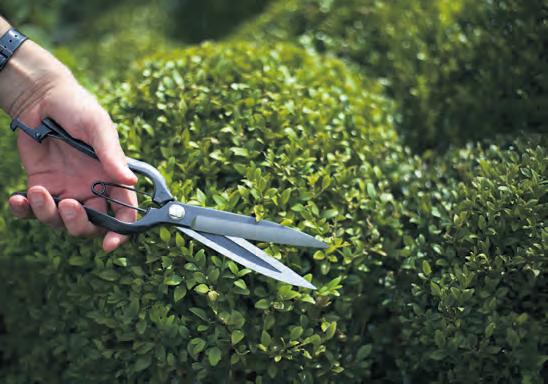
Use a box alternative, such as Ilex crenata (which forms the low hedging at Levens Hall), Euonymusjaponicus ‘Microphyllus’, or Loniceraligustrina var. yunnanensis ‘Maigrün'.
"I love topiary because it looks good for 10 months of the year," says Charlotte Molesworth, creator and owner of the beautiful Balmoral Cottage topiary garden in Kent, England. "It acts as a backbone to all other planting. And if you use yew or box, it only needs cutting once a year."


If you don’t want to clip freestyle, purchase metal frames (available in a range of shapes) to clip around. Large topiary will require a step-ladder and the best hedge trimmer too. And if you’re going for super straight lines, you'll need a spirit level.

Typically box (Buxus sempervirens) and yew (Taxus baccata) are used, however other evergreens such as privet (Ligustrum japonicum), holly (Ilex) and Lonicera nitida can be used.
Trees and shrubs can be bought ready-trained from specialist nurseries; these save time and effort, but can be expensive. Also available are plants with topiary frames over the top of them, which allow you to grow your own topiary with a little helping hand. Choose a young, well-proportioned specimen with dense, healthy-looking growth, especially near the base.
Firstly, and most important, decide on the shape you are trying to achieve. Balls, pyramids and cubes are a few of the easiest shapes to start with. Large or horizontal shapes may need more than one stem.
Then choose which plant you would like, and whether it is to be grown in the ground or in a pot, and then plant it.
To encourage strong, healthy growth, apply an annual dressing of fertiliser and mulch in organic matter in the spring. For standard specimens (e.g. lollipops), select one upright shoot to act as your main stem, tie this to a cane or stake and remove all others. Gradually clear the lower part of the stem of shoots and foliage, continuing until the desired height of main stem is reached (which could take several years).
Canes are primarily used as plant supports. The fruiting stems of blackberries, raspberries and hybrid berries (such as loganberries and tayberries) are also known as canes, so these crops are often referred to as cane fruit.
Begin clipping it into shape. You could do this by eye or make a template or a wooden frame to ensure the shape is clipped uniformly.
As the plant matures, it will bush out and the branches and leaves will become tightly knitted together to give the solid appearance. This can take many years, depending on the plant selected and the ultimate desired size.
Allow for the plant to grow to the desired height before its main leader is trimmed.
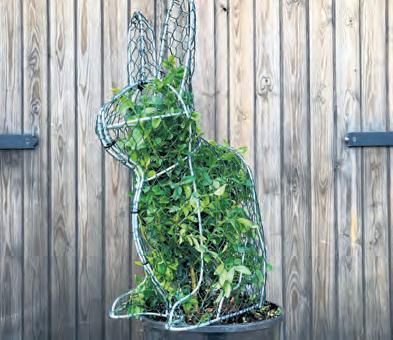
• Take a cone-shaped evergreen (such as box or cypress).
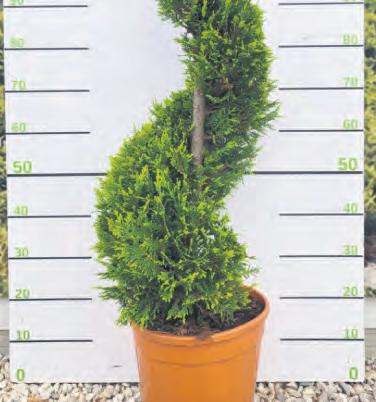
• Tie white string to the top and then wrap it around the plant, so that it creates a helter-skelter look. A 3ft (90cm) cone might have 6 or 7 rounds cut into it.
• Using one-handed topiary clippers or sharp kitchen scissors, begin to snip into the plant, gradually creating a gutter behind and around the string.
• Once you’ve created the basic skeleton shape, remove the string and clip until you have a series of neat, curvaceous whorls.
• Take a bushy evergreen shrub (such as yew or box) that’s at least five feet.
• Create a base or plinth for your rabbit to sit upon, by clipping a dome shape into the lower two-thirds of the plant with garden shears.
• Study the upper part of the plant and decide which dominant stems will create the head and tail.
• Tie the front stems (that will form the head) together with string and lightly cut into shape.
• Bind the stems that will form the tail, using string and a cane to create a vague fan shape.
• Cut back the rest of the upper section to create a body that is lower than the head and the tail.
Moving house is stressful enough and there’s always sadness, memories you leave behind. For me leaving our Cotswolds garden was really emotional. When we bought the house 15 years ago the house was in good condition, but the garden wasn’t and I, with my husband’s help and hard work transformed it with a lot of love, green fingers and cash.
The house had grown too big for us, and we would have loved to have taken every bit of our garden with us to a new home just outside of Dorchester but obviously that’s not possible.
When we started looking into the procedure we were told garden plants form part of the sales agreement, so removing them without the permission of those moving in can invalidate the transaction.
So, OK we thought, let’s just have a conversation with the new owners and ask them if we can take a few plants with us, plants which we have loved and would miss, and which wouldn’t leave too many holes in their garden.
As an example I quoted Christopher Lloyd’s mother’s favourite rose, ‘Florence Mary Morse’. I don’t think this is a beautiful rose, but I do think it’s a wonderful plant, which produces masses of rich, red flowers just about all summer. I had grown to love it.
I would like, I said, to take it with us.
We didn’t make any list or give any idea of what we were
looking to take with us mainly because we didn’t know. What came back from the buyers’ solicitor was a ‘No way’ letter suggesting there had been a huge increase in so-called ‘garden grabbing’ - where people load garden plants into their removal vans alongside their furniture when they move house.
My husband felt however not sentimentally attached as I was to larger plants; they were better left where they are as they get very established within a couple of years. Attempting to move them may do more harm than good. Our solicitor was keen to avoid confrontation and suggested we secure our rights to anything from the garden to avoid any misunderstanding. We should he said list the plants, containers, garden ornaments, bird tables, etc, that we wanted to take with us as we would with the fixtures and fittings in the house, as once contracts were exchanged, both parties are legally bound in agreement. Was I being unreasonable to take some of my plants with me? I had spent a lot of money getting flowers to establish and even some small trees that I love. I would like to take those with me which I felt should be able to be moved. If there was a question of them being moved and damaged then clearly I wouldn’t do so.
You wouldn’t leave a favourite painting on a living room wall. Why leave a much-loved plant?

Our solicitor urged common sense. As a rule anything
over five years old shouldn’t really be moved he suggested. He did some research on our behalf and found the top five plants to be taken are Japanese maples, magnolia, roses, snowdrops and expensively sculptured bushes. His letter to us was supportive in principle and he concluded what he would argue with the buyers that: “Many plants have spent a lifetime with their owners, sharing their ups and downs across the years. Over the decades, plants become friends.”
Our ‘garden list’ to take with us in the end included everything in containers, ornaments, sculptures, bird feeders . I wanted the Christopher Lloyd rose, a recently planted acer, a selection of snowdrops so we could build a new snowdrop dynasty in our new garden, a plum tree planted last autumn and a gift from my son, and about five other easily moved shrubs. Suffice it to say the list proved to be something which sparked off disagreements and bad feeling which almost, and I say almost, meant the whole house sale being called off. The new owners seemed to take it as an affront that we were destroying their new garden which had been one of the reasons they wanted to move in.
We just wanted to take some much-loved possessions. No-one it seemed knew what the correct etiquette was. The story didn’t have a happy ending. We compromised as we didn’t want to start again with the sale and in the end took very little.
 READER’S STORY
READER’S STORY
Virginia Scott moved house in August and left a garden she had worked hard in for 15 years. She wanted to take some of it with her to her new Dorset home, but things didn’t go completely as she had hoped.

There’s always some sort of compensation going on in the world of gardening. In October the temperature drops, the days are shorter but then in compensation there’s the wonderful, much-loved colours of autumn.
The dramatic colours of autumn are a huge attraction and this year promise wonderful days out as gardens change their colours from the vivid summer hues to the browns and golds of October and November.
The south west has some wonderful gardens and arboretums which come into their own as the days shorten and get cooler. Lukesland, Forde Abbey together with Batsford and Westonbirt Arboretums all have magnificent collections of trees producing vibrant reds, browns, and yellow and perfect walking venues.
There is still enough light in the days to get out and about for holidays and shopping trips as well as traditional garden visits before winter descends. Here’s just a few places offering a lot of rewards to visit.
As we head into October there are some wonderful allotments and kitchen gardens opening with the National Garden Scheme. Growing your own produce can help keep you fit and motivated and inspire a great sense of optimism and the gardens are the perfect place to get you started. With most open gardens selling tea and cake, a visit makes a perfect, affordable day out.
Find a garden open near you: ngs.org.uk
Boscrege Caravan and Touring Park in Cornwall is a peaceful and picturesque park, set at the foot of Tregonning Hill, Godolphin National Trust and amongst tranquil Cornish lanes in an area of outstanding natural beauty. The park, open all year is close to the Cornwall coast and a few minutes’ drive to Praa Sands, one of Britain’s nicest beaches. So, if you are looking to take a luxury holiday (doggie friendly with dog friendly homes and on-site designated fields for the dogs too) in Cornwall in a either a self-catering caravan, lodges touring or even purchasing your very own holiday home then contact Boscrege Caravan and Touring Park.
Boscrege Caravan Park, Boscrege, Ashton, Cornwall TR13 9TG
Tel 01736 762231 www.caravanparkcornwall.com
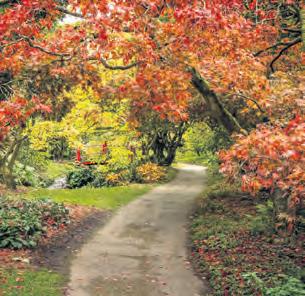

You can discover the beauty of Japanese maples, sorbus, euonymus and cherries at Batsford Arboretum this autumn and enjoy a magical stroll through a kaleidoscope of reds, pinks, and golds, guaranteed to leave you in awe. Visit the garden shop for all your gardening essentials and the walled garden plant centre for a vast selection of quality plants. To top it off, enjoy a breakfast, lunch or afternoon tea at the Garden Terrace Café.
Plan your visit to the Arboretum in advance during autumn by booking via www.batsarb.co.uk
Batsford Arboretum & Garden Centre, near Moreton-in-Marsh, Gloucestershire GL56 9AT Tel 01386 701441

The arboretum at Forde Abbey explodes with autumn colour from late September. The popular gardens are open one last month for this year. The coffee shop will be open throughout the day serving hot drinks, cakes, and light bites from 10.30am until 4.30pm. The gift shop and Eeles Pottery will also be open along with the in-house plant nursery from 10.30am to 5pm.
There is still time to admire the herbaceous border which were planted with focus on summer and autumn flowers throughout the gardens and bunches available at the Gift Shop. Forde Abbey will be celebrating harvest week from the kitchen garden at the end of October, and back by popular demand there’s a fun activity for children and adults,‘The Pumpkin rolling’ is from 21st – 31st of Oct. There will be plenty of pumpkins for you to choose from. You can purchase one to roll it down the slopes and then take it home to carve for Halloween or just to make a delicious soup. October is full of spectacular autumn colour too, with some of the champion trees looking better each year. The house is closed on Saturdays and Mondays, but the gardens are open daily.
Forde Abbey, Chard, Somerset TA20 4LU






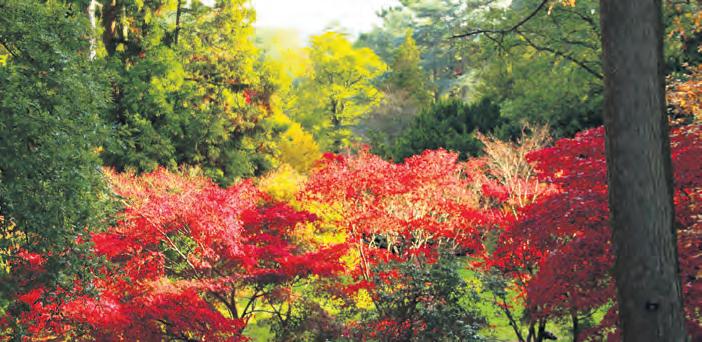
Head straight to Westonbirt, the National Arboretum to see a dazzling display of vibrant reds, yellows, oranges and purples. You will be rewarded by seeing over 15,000 trees putting on one of the world’s most spectacular natural colour shows this autumn. Find out more about the best seasonal features of the Old Arboretum by joining one of the daily guided walks, led by experienced and knowledgeable guides ready to point out some hidden gems.
For all this and more information about the popular magical light trail coming soon, Enchanted Christmas, see Forestryengland.uk/westonbirt


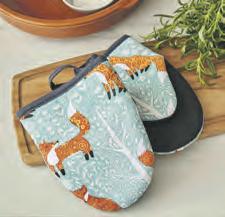
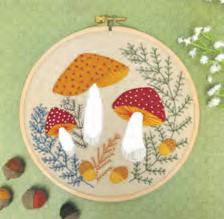


Westonbirt National Arboretum, Tetbury GL8 8QS









An RHS partner garden with a Grade I listed medieval priory backdrop. A mix of classic and modern features, including a ‘hot’ border, sub-tropical walk, blue garden, Mediterranean garden, shade border, Southern hemisphere and a winter garden. Home to Somerset’s only botanical glasshouse, featuring hundreds of different species from around the world such as the magnificent jade vine (Strongylodon macrobotrys). There’s also a gift shop, tearoom and specialist plant nursery; plants are propagated on-site and sold at great prices! Open Tuesday to Sunday, 10am to 4pm, all year-round excluding two weeks at Christmas. Last admission to the Gardens is one hour before closure. Check the website for variations.
Church St, Cannington, Bridgwater TA5 2HA
Email: walledgardens@btc.ac.uk Tel: 01278 655042


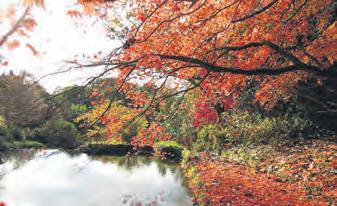

Tucked away on the southern edge of Dartmoor, just north of Ivybridge, Lukesland is a wonderful place to enjoy autumn colour. The shelterbelt of beeches, planted by the Victorians to protect this 24-acre garden from Dartmoor winds, turns to gold, while more exotic species such as acers, cercidiphylum, cornus, enkianthus, ginkgo and swamp cypress reflect their autumn tints in the pools of the Addicombe Brook. Visitors often comment on how peaceful the garden is, with the gentle sound of the tumbling stream constantly in the background, as you wander on twisting paths through this woodland valley, with new views around every corner.
Openings are on Sundays and Wednesdays 11am to 5pm from 11th October till 15th November. No prebooking is required. The tearoom is open with a simple menu of home-made soup and cakes. There is also a fun trail and a Sound and Story Garden for children. Dogs are welcome on a lead.
For more details about Lukesland phone 01752 691749 or go to www.lukesland.co.uk or www.facebook.com/lukeslandgardens
Corfe Castle is one of the most iconic landmarks in Dorset, but did you know it’s surrounded by a pretty village with the same name?
From the castle you’ll see the village laid out like a map below, with the church, pubs, cafés, galleries and shops. A favourite of these is Seasons Green, full of gorgeous items inspired by plants, flowers and the English countryside. Known for it’s selection of unusual gifts, art and crafts, it’s, like the whole village, a chocolate-box-pretty shop full of character. After some shopping, visit the model village, the tiny (free) museum and then head home, catching a glimpse of the steam train puffing its way alongside you as you go.
Velvet Pumpkins from £3.75, Foraging Fox Linens from £7, Pumpkin Bunting £7, Handmade Leaf Wreath £32, Pheasant Cushion £49
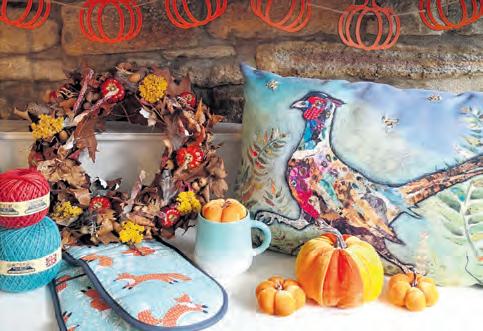
Season’s Green 14 West St, Corfe Castle, Wareham BH20 5HD

Lukesland Gardens Lukesland House, Ivybridge PL21 0JF forestryengland.uk/westonbirt
Find
Home-made

Autumn is most definitely and officially with us, in all its golden glory. The ground is wet with dew in the mornings and the garden starting to be covered in cobwebs, but some days into the month will feel glorious and still warm. The damp and often miserable July and August means that leaves are not falling early from the trees and a lot of summer crops had a boost with that wonderful September sunshine.
Preparation for winter is in full swing – fruit and autumn vegetables are starting to be ready to be brought in and stored, and plants should be cut back, wrapped up or brought inside to help them survive the chilly winter temperatures.
Broad beans are very hardy and some broad bean varieties produce much earlier crops if sown in the autumn. On heavy soils that stay wet through the winter they can be prone to damping off or rotting. So, it can be a good idea to start them off in pots in the greenhouse and plant them out in the early spring as the soil warms up again.
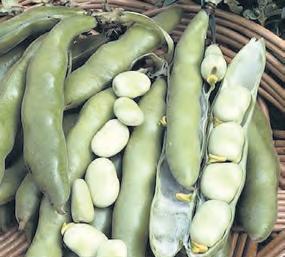
You need hardy varieties such as ‘Aquadulce Claudia’ to make the most of over-wintering.


If you’ve got tender plants, such as canna, now’s the time to bring them indoors before they get killed by the frost. Choose a light, frost-free place such as a greenhouse or coldframe. Then keep them on the dry side during the winter, so they don’t put on much growth.
The plants can then be brought back into growth in spring by gradually increasing the amount of water they receive.
Late autumn and winter is a great time for planting trees. If you are dreaming of a new orchard, now is the time to start planning. A visit to one of the many apple days around the south and southwest is a great opportunity to try some of the less well-known varieties. Growing your own is a great opportunity to be able to grow one of the several thousand varieties that aren’t available in the shops.
Frosts will eventually bring an end to their glories but until then do keep deadheading. A quick way to tell flower bud from spent head: the spent heads are pointed in shape, the buds round.

Prepared hyacinth bulbs can still be planted now. Use bulb fibre or general-purpose compost but don’t be tempted to use ordinary soil which might contain worms. Bulbs should be close but not touching either each other or the sides of the pot. Fill with compost allowing the tips of the bulbs to show. Water, but don’t overwater, and place in a cool dark cellar, garage or somewhere similar. Check regularly, watering a little if necessary. You don’t want them to dry out. Once the shoots are a couple of inches high you can bring the pots indoors.
Wildflowers only need to be cut down once a year. Wait until they have finished flowering and the seed heads have ripened, adjust the lawnmower wheels onto their highest setting, remove the grass collection box and run the mover over them, or if you fancy a lot of exercise, try a scythe. Leave the cuttings on the ground for a few days to allow any seed heads to dry and for the seeds to fall. Collect up the remaining stems and put them in the compost heap.
It’s not too late to get your spring cabbage plants in the ground. ‘April’, ‘Durham Early’, ‘Offenham 2’, and ‘Spring Hero’ are varieties that you could try. Although they won’t grow much over the winter, they should flourish next spring.
You should space young cabbage plants as far as 18 inches apart, to give them plenty of space to grow. They’ll also need a good amount of water when they’re first planted. Cabbage plants are quite hardy, so they should be perfectly fine during the winter, unless it’s exceptionally cold. In this case, you might find it helpful to use a cloche (a cover) to protect them.
One of the main issues that young cabbage plants face is that they risk damage from pigeons. To counteract this problem, you can stick a couple of feathers into a potato and hang it from a string over your cabbage patch, to ward them off. The pigeons will think that your cabbages are being guarded by another bird and will usually keep away.

Turning the compost heap is important at this time of year. As the garden is tidied in preparation for winter, lots of material is generated for composting so don’t just load the new material on top of what has been decomposing during the summer. To encourage the whole bed to rot down quickly, turn the contents regularly to stir it up and allow in lots of air. In the colder weather, the rate of decomposition will naturally decrease, but it will soon speed up during warmer spells.
If you have a productive fig tree, take cuttings now. They should be about a foot long, this year’s growth, with the softer tip removed. Cut the tip-end at an angle so you know which end is up then insert cuttings into a trench of welldrained soil.
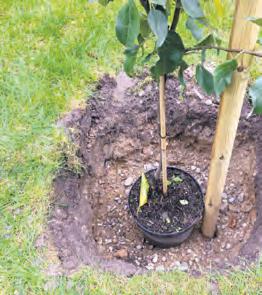
Weeds will still be germinating and growing strongly in mild periods of weather, so be vigilant and remove them when you see them. Try to dig them out rather than pulling them up, as you’re more likely to get them out with roots and all that way.
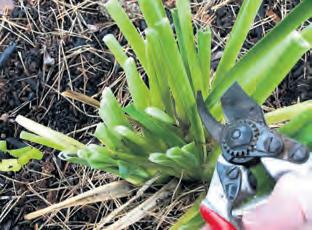
Perennials are not demanding plants, but trimming them after flowering finishes in autumn helps improve their appearance and flowering. However, you can leave some stems over winter to provide homes and food for wildlife, and then trim back in spring.
Cutting back herbaceous plants during autumn restores order and tidiness to the garden. However, this removes potential winter interest, in the form of height and structure, plus food and habitat sources for wildlife so think about delaying the cut back until spring.
If you want your garden to have a fresh burst of colour during the winter, then consider planting pansies this month. Winter pansies are hardy plants that will often continue to flower throughout the coldest months of the year.

A bog garden is a fantastic and low maintenance alternative to a pond. If you have a part of your garden that always seems to collect water then it’s a great way to use that space - creating something more attractive that provides habitat for wildlife
Pansies have an amazing ability to adapt to frosty temperatures and still come out strong in the spring. However, they must be planted at the right time to achieve this (when the soil is between seven to 21°C). After flowers have bloomed and began to wither, they should be pinched off to encourage new flowers to continue growing.
Rhubarb is a great plant for the vegetable border but it does need revitalising now and again. Dig up big old clumps and divide into pieces using a sharp spade, making sure that each division contains a piece of root and a shoot, then discard the old centre. This is also the time to buy and plant new rhubarb crowns.
Plant new crowns any time from now onwards through to the end of November. If the weather is reasonably dry and mild then you can plant through to the end of the year. Buy named cultivars, or choose a division from a strong, healthy-looking plant. On wetter soils, planting with the buds just raised out of the soil may help prevent rotting. If planting more than one crown, space plants one metre apart, with one to two metres between rows.
For an even earlier harvest, lift some roots in November. Ideally leave the lifted roots outside for up to two weeks prior to potting to expose them to more cold - this is needed to overcome dormancy.
Large areas of bare soil start to appear in all parts of the garden. If left over winter, the soil will lose nutrients. Use organic mulches to protect it and give good structure for next year’s growing season. Best mulches are a thick layer of autumn leaves, wetted so that they don’t blow away,straw, grass clippings and autumn leaves mixed together, cutback plants such as sweet peas, peas or runner beans, chopped up sheets of newspaper, covered with damp grass clippings to weigh it all down.
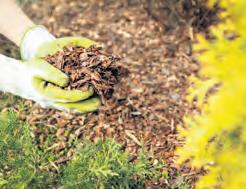

Garlic is such an easy and rewarding plant to grow and has the benefit of being able to store when picked.
Late October is the ideal time to plant garlic, because it needs a one to two month cool period to encourage good bulb development before the spring.
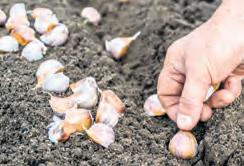
To plant garlic, all you need to do is break up a bulb of garlic into segments/cloves, and plant them in welldrained soil, two cms below the soil’s surface. The flatter end (that you would normally trim off) should be pointing downwards. Try to choose a spot that’s open and well-lit to allow the garlic to receive maximum sunlight throughout the winter.
In terms of spacing, it’s best to allow 15cm between individual cloves and 30cm between each row of cloves. Garlic doesn’t do too well in an acidic soil environment (below pH of 6.5), but it’s easy to increase the pH of your soil by adding garden lime to it during the autumn and winter months.
The bulbs need cold in order to separate into cloves. ‘Picardy Wight’ originates in northern France, so it is better suited to our cooler and wetter growing conditions than some.
A watertight barrel is a perfect home for a bog garden which caters for aquatic plants and doubles up as wildlife habitat.
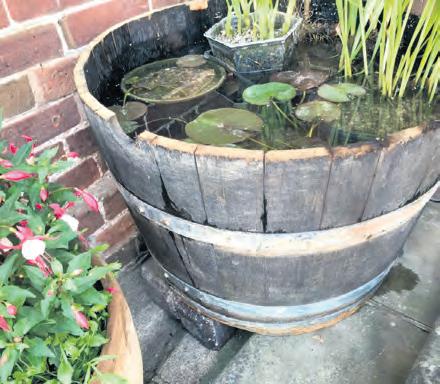
An old whisky barrel cut in half is ideal, but you can use all sorts of things like ceramic pots, old buckets, baths, old sinks.
If you are looking for something a little bigger, have a look at feeding barrels for livestock. You can buy already treated half barrels for around £100 from garden centres or general garden suppliers.
By using such a container you will be able to grow a whole range of moisture loving plants which otherwise will not thrive in your garden. Such water features are a haven for all sorts of invertebrates with muddy soil providing habitat for mud dwelling larvae and flowers which will attract insect pollinators. There are also a whole range of plants which will thrive in shallow water or wet ground which you would never be able to enjoy.
FLOATING AQUATIC PLANTS – (pondweed, water lily) – These shade the water and stop it from getting too warm, this helps prevent blanket weeds and algae and provides shade for wildlife in the water. Speak to your local supplier and make sure they are not too evasive, some can take over your whole container very quickly.
OXYGENATORS – (hornwort, spiked water-milfoil) – These plants help keep your pond clean and algae-free. You can buy flowering oxygenators and non-flowering like the hornwort that sinks to the bottom of your container. Having ample oxygenators for your mini ponds means you don’t need a pond filter.
MARGINAL PLANTS – (water mint, cuckoo flower, water avens, brooklime) – These sit on the edge of a pond and are great for newts and other wildlife to use to climb out.
If you grow a bog garden you’re in for a real treat, because the moisture loving plants of the bog are colourful and dramatic. Many grow big and tall and can make a real statement in your garden. Create contrasts with a variety of uprights, foliage, bold broad-leaved plants and filigree ferns. Have fun with the following species:
• YELLOW IRIS – great for perches and to give summer colour
• PURPLE LOOSESTRIFE and MEADOWSWEET - good to create height
• CREEPING JENNY – great ground cover
• MARSH MARIGOLD – good early blooms in spring
• HEMP AGRIMONY – fantastic autumn colour
• WILLOW and DOGWOOD – their colourful stems create winter interest
Cost estimate
£156 (£100 for the barrel and £56 for a range of 15 bog garden plants).
• Choosing the right container is important. Select one without drainage holes Place bricks inside to create a supporting shelf. Fill around the bricks with aquatic compost.
• Many bog plants are vigorous growers. Keep an eye on your container and if it looks like any plant is taking over, reduce or remove it.
• Create a wildlife perch. Stones make a perfect pitch for wildlife to drink from and it will help your water feature look more realistic.
• Don’t forget to top up the water when levels drop.
For anyone considering planting trees and shrubs, spring bulbs or roses then it is October which needs to have the focus when it comes to getting plants in the ground.
So much emphasis is on the spring being the focal point of the gardening year that too many of us don’t consider what are probably the most important few weeks of the year – October and the planting season.
It’s the month when gardening activity should be at its peak-not just seasonal tidying up but getting things in the ground for next year.
If you don’t plant in the autumn, your garden won’t flourish until the last three or four weeks of spring.
You can plant pretty much anything over the next few weeks; it’s the best time of year for planting as the soil is warm and perhaps not wet in this drought
affected summer but with adequate watering when planting the principle remains the same. The warm soil allows roots to grow until the ground freezes, whereas in the spring, plants don’t grow until the soil warms.
It’s also the time to give plants the best chance of strong growth including watering systems , nutrients or quality composting material. There’s an exciting choice for gardeners looking to get gardening.
Autumn is for example the best time to plant spring flowering bulbs. It helps to plan, so you have your selection of bulbs ordered and delivered in time for planting. There are lots of wonderful nurseries who have an amazing range of spring bulbs for sale.
It’s also the time of the year to buy that special tree or plant and get your soil well and truly prepared.
When it comes to giving bulbs a fast start choose Empathy Bulb Starter when planting. This powerful blend includes vermiculite for better drainage and bulb protection, Rootgrow mycorrhizal fungi to boost root health and seaweed meal to enhance root growth and fungal development. Mycorrhizal fungi are essential for bulbs, elevate your bulb gardening with Empathy Bulb Starter.’ www.rootgrow.co.uk


Barthelemy & Co near Wimborne in Dorset was established by a French nurseryman almost a century ago and the Skinner family now specialise in propagating and growing acer palmatum – or Japanese maples as they’re known. Throughout spring, summer, and autumn the delicate foliage of the acer presents exquisite shadings of Mother Nature’s gold, pink, purple, green, yellow, orange and red. Acers are a delightful addition to anyone’s garden, giving an aura of peace and tranquillity. The ten-acre nursery at Stapehill has a huge collection of Japanese maples and expert staff are on hand to help select the right variety and to offer advice. Over 100,000 acers are produced at Barthelemy and Co every year and approximately 15,000 - 20,000 of them are grafted named palmatum varieties, as one of the largest specialist growers of their kind.
Barthelemy & Co 262 Wimborne Rd W, Wimborne BH21 2DZ
Tel: 01202 874283www.barthelemymaples.co.uk


Now the growing season is in full swing it’s very difficult to keep up with fast growing shrubs and climbers which need to be kept under control and well staked. One great idea is using Rivelin Glen Products which are well designed wire anchors. They are quick and easy to attach to concrete posts (without drilling) to act as an ‘eye’ by threading wire through them to create a trellis system. The Gripple Trellising System is ideal to use with these Wire Anchors as the wire does not stretch, takes up to 100kg load and has a life span of 15 years. You can achieve multiple rows with one length of wire and two tensioners so it’s no more sore hands or sagging wires. Rivelin Glen Products are the main stockists of the Gripple Trellising System. Wire Anchors cost from £10 a pack of three. Gripple starter pack £19.75p.
Email info@rivelinglenproducts.co.uk or call 01246 462666 www.rivelinglentproducts.com




If you have any views, ideas, suggestions comments or gardening tips you would like to share with Country Gardener readers then email us at editorial@countrygardener or write to us at Mount House, Halse, Taunton, Somerset TA4 3AD
We have a self-seeded sunflower growing in our vegetable patch. Self-seeded either from our compost (in another area we grow the small usual four-to-five-foot sunflowers each year) or dropped by a bird.
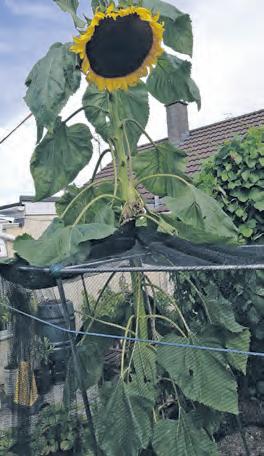
We watched it grow, and grow, until it pushed up the five ft high netting covering the vegetable patch, at which time we had to re-configure the way the netting ran and give the plant some support. As it got to nine feet high it started to break the framework apart; so much tying to various part of the frame became necessary. Now it has reached 11ft [not a recordbreaker] but has a flower that is 18in across from petal to petal. The trunk is as thick as my forearm, a nine-inch circumference, and it is unbelievably heavy so leans a lot as it is only on a garden cane! I have now had to get a hook near the top and use a long piece of binder cord to bring it straighter and secure it against something strong - i.e. tie it to the conservatory. It’s the talk of some of our neighbours.
Martin B. Dymond Midsomer Norton
My neighbour has a sign on his garden as you enter it next to his garden bench which says ‘Please be seeded’- it makes me smile every time I see it.
I recently found some old photos of my grandparent’s garden, I think in the early 50s and it showed me what gardening meant then. Gardening wasn’t high on the things to do in scarce leisure time. There were no garden centres, money was tight, rationing was in force and no one wasted space in a garden on anything which couldn’t be eaten. A lot of my grandparent’s garden was taken up with potatoes but there are also pictures of rhubarb, radishes, lettuces and marrows. Livestock was found in most gardens, rabbits for the pot and chickens for eggs and the table. The garden was small, incredibly productive, a credit to them both and provided my grandparents with a respite to what was still a harsh life.
 Naomi Colman Hereford
Naomi Colman Hereford
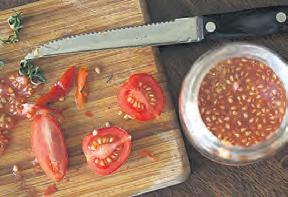
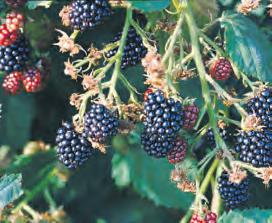
I have been saving tomato seeds for years now. It’s a bit messy but worth it. Just smear the seeds, liquid and all on a sheet of toilet paper and leave it to dry for a few days. Then snip up the paper, with one seed to each bit and store them until next year. It’s a method which has served me well for about 20 years.

My father has again been showing us his potato harvest which produces the most wonderful crop year after year. Growing potatoes is simple he says. He has a system which means getting started in the autumn when he will ridge up the soil where they’ll grow the following year. He then applies compost and a few weeks later manure. It’s the overwintering of the soil which is the secret he says. He then plants the potatoes in March. I read recently that old-time gardeners have always said preparing the soil in the autumn is the trick for great potatoes. And my dad proves it year after year.
Cindy Lambert West SussexI have been following the letters in your magazine about dogs being a problem in some gardens which open for charity. I open my garden twice a year and I have to say dogs are not the issue – but young children are. Adults with young children don’t seem to tell their children that these gardens are not a playground when there are other people trying to enjoy them. Our garden is lovingly maintained and full of carefully chosen and unusual plants and is a haven for wildlife. In recent weeks it took me ages to retrieve the gravel a little boy had removed from one area and dumped in our greenhouse and I’ve had to stop them playing ‘chase’ in the flowers beds. By the way I’ve never had an issue with dogs, but five year olds are a different matter.
Tessa Coleman PetersfieldWhen I arrived at my current address, my neighbour passed me a bag of wizened broad beans over the fence. He proudly told me he and his father had grown broad beans from the same stock since 1925, year after year. I have carried on the same tradition meaning that the beans I have just harvested come from a pedigree of almost 100 years!

I saw your letter about blackberries this year and we have been growing cultivated thornless blackberries for a few years. I know most gardens are full of the traditional varieties, but I would recommend growing some special ones. They are bigger than wild ones and much tastier. This year has been perfect for them. We had a nice May and June when the temperatures were good. June was warm but not too hot, allowing the flowers to take up enough nutrients and the pollinators to do their thing. Then after June we had quite a lot of rain, which did the berries a world of good, plumping them up. In the last few weeks, it’s been warm, meaning they’ve ripened well and its one of the juiciest crops for years.
David Waters WiltshireWe had an informal meeting the other night at the allotment- well more of a cup of tea and a chat. The subject was cucumbers, or the lack of them. It seems that everyone has been having problems with growing them this season and it’s hard to fathom why. Mine for example started well in the greenhouse in April and May but then just stopped growing and by the end of May were clearly not going to amount to much. My ‘neighbour’ on the allotment says he hasn’t had a bad cucumber year in about a dozen years of growing them but this year he hasn’t been able to take any home I think everyone felt the same. Cucumbers can be notoriously difficult to get going and its only when they have put on the initial burst of growth that they accelerate away. They never seemed to reach that all important stage so that suggests it’s not the seeds or the watering but perhaps a virus or poor pollination. So no cucumber sandwiches for tea.
Dave Braes WestonHANGING BASKETS NEEDN’T BE ALL ABOUT COLOUR AND DRAMA- HEUCHERAS AND HEUCHERELLAS HAVE SUCH WONDERFULLY VIBRANT FOLIAGE THEY MAKE AN AUTUMN DISPLAY WITH A MODERN LOOK
Hanging baskets are not everyone’s cup of tea. They can be a bit too colour heavy and brash and rather brutal on the eye.
Broad beans have large seeds, produce big seedlings and grow quickly.
If you sow broad beans in the autumn you can look forward to an earlier crop than those sown in spring, usually in May. These hardies vegetable patch stalwarts are among the easiest crops to grow, and well worth trying this autumn – their only requirement is free-draining soil as sometimes too much winter wet can hamper their survival.
Most broad beans are hardy and shrug off cold winter temperatures. Winter wet can rot their roots, however, so if you have very heavy clay soil, you will probably be better off waiting till spring to sow your seeds.
For autumn sowing, pick the hardiest cultivars, such as reliable ‘Aquadulce Claudia’ or The Sutton). The latter is a dwarf variety particularly suited to smaller gardens.
You can sow broad beans directly into the soil, but to minimise losses and ensure full rows with no gaps, you can also sow them into pots filled with multi-purpose compost. Then, once the young plants are big enough to handle at around 10cm tall, move them into their final positions in the vegetable patch.

Plant your beans about 25-30cm apart in rows so there’s plenty of room for air to flow between the plants. This helps minimise the risks of your broad beans contracting the fungal disease chocolate spot.
Once fully grown, the plants will need staking.
Broad beans have been cultivated for thousands of years and the reason for this is simple: they are very nutritious, and they produce a large crop for the area they occupy. The very best broad beans are those just slightly smaller than the average man’s thumbnail, at this size they are sweet and tender with a thin skin.
Autumn sowings are best made directly into ground in the third week of October. At this time of year, the soil will still be about the correct temperature for germination. The two major problems with autumn sowing are cold and water-logging. Whilst you may be able to predict the temperatures with some accuracy, the amount of rain which may fall before
spring is almost impossible to predict. The minimum temperature at which broad beans will germinate is 7°C / 45°F. If cloches are in place, or the ground is covered in plastic, the soil temperature will be approximately two degrees higher than shown in the above diagram, the ground will also be drier reducing the risk of the seeds rotting. The soil temperature is the key to sowing broad beans in autumn. If the temperature is high enough for just a couple of hours, the seeds will start the germination process.
Broad beans are too bitter to tempt slugs and pigeons, but they will almost always be afflicted by blackfly. If your broad beans have gone from lush and healthy to covered in black then blackfly, or black bean aphid, has struck. Blackfly on broad beans is easily remedied and it won’t affect your crop if you act quickly.
Blackfly feed on soft plant growth. They’re commonly found feeding in large numbers on the soft shoot tips of broad bean plants. If you allow blackfly to colonise these tips, the result will be stunted growth and a poor crop.
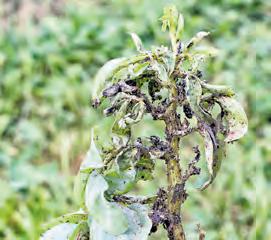
The best way to avoid blackfly on beans is to check the plants daily. Blast off blackflies with a jet of water as soon as you notice them on the tips. Alternatively, you can use a damp cloth to wipe them from the leaves.
Heavily infested shoot tips are best cut off and binned. Snipping off the shoot tips of broad beans also helps the bean pods to swell. Snip them off when the pods have started to form, even if you don’t have a blackfly infestation.
But there’s a solution to all this which is the introduction of a whole new colour range into hanging baskets- brooding plums, burnished caramels, lime greens and subtle coral colours. It relies on the use of a group of wonderfully versatile plants which celebrate the colours of autumn.
If you want to add colourful and eye-catching foliage to your winter hanging basket, consider heuchera and heucherellas , which can be packed into the top of the basket.
Heuchera, commonly called coral bells specially in the United States, are easy to grow. They produce small flowers on stems that rise above their foliage, but they’re primarily grown for their lovely leaves. Flower colours include white, pink, light coral, and dark red.
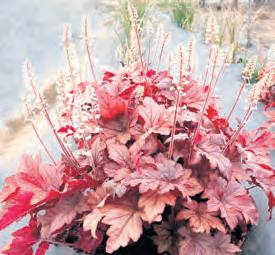
Heucherellas are a cross between heucheras and tiarellas, and you get the best of both worlds with these plants. They combine the disease resistance of tiarellas with the colourful foliage of heucheras. They also are more shade and moisture tolerant than heucheras.
They provide just about everything you could want in a hanging basket : they add a burst of colour and variegation, they naturally mound, so they fill in a pot very nicely, and they are relatively low maintenance.
Effortlessly add vibrant hues to a hanging planter with heucheras . Like all plants, they need a bit more care when grown in a container.
They’re available in a wide variety of foliage colours. Mix a few varieties to create a gorgeous container garden or combine them with other types of plants if you want more flowers in your container garden. Hanging baskets in the autumn are a pretty way to spruce up your patio, balcony, deck, front steps, or to cover a bare spot in your garden.
Their medium to large leaves are heart-shaped or rounded. Many are variegated or have ruffled edges. Choose from varieties with lime, burgundy, chocolate brown, purple, or multiple shades of green.
They are not heavy feeders, so a slow-release fertiliser like compost is the best option to use. Add a half-strength solution of a water-soluble fertiliser every six weeks throughout the growing season.
However, plants grown in containers typically need to be fertilised more often because the nutrients in the soil are leached away due to more frequent watering. If you prefer, you can keep your plants looking their best by applying a water-soluble fertiliser every other week during the growing season. It is unnecessary to fertilise them during the winter when the plant is dormant.
Rich soil with a high organic matter content is a good pick for these plants. Mix in compost or manure to create good soil. Well-draining soil is necessary because Coral Bells like to dry out between watering. You may also use a good quality all-purpose potting soil for your container grown heucheras.
Add a half-inch layer of compost on top of the soil when initially potting them up. Be sure not to cover the crown of the plant with soil or compost. Don’t forget to water regularly.
SOME AUTUMN COLOURS WORTH CHOOSING:
• Heucherella ‘Sweet Tea’ - Burnt-orange foliage that darkens throughout summer.
• Heucherella ‘Stoplight’ - Chartreuse yellow leaves with contrasting, dark-crimson markings.
• Heucherella ‘Redstone Falls’ - Vibrant green and ruby red leaves creating a mixture of autumnal colours which change.
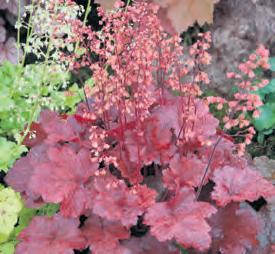
Choose the right variety and these hardiest of beans sown in October will provide the earliest and most rewarding of harvests next yearHeuchera ‘Cherry Cola’
Bridford, Nr Exeter EX6 7LB 01647 252654
Traditional Nursery Trees, Shrubs,Climbers and Perennials Hanging Baskets, Patio and Vegetable Plants Garden Shop, Local Produce Competitive Prices www.teignvalleynursery.co.uk teignvalleynursery@gmail.com


Fine Turf (Devon) Ltd, a family run business established a locally seeded turf, suitable for a variety of gardens, which treated and fertilised several times throughout the growing

We also supply topsoil, composts and landscaping bark for all your gardening needs, we can mix these for your requirements for planting flowerbeds and vegetable plots. All our topsoil is certified and stored dry all year round, as are the composts.
WE SUPPLY LOCALLY SEEDED TURF, TOPSOIL, COMPOSTS (MUSHROOM/ORGANIC GREEN WASTE) AND LANDSCAPING BARK, WHICH WE CAN DELIVER OR YOU ARE WELCOME TO COLLECT.

01364 652538

•
Edits/Declutter

• Personal Shopping

Fine fineturfdevon@gmail.com
Lower Waye Farm, Ashburton TQ13 7ET
•
Lower Waye Farm, Ashburton TQ13 7ET TEL: 01364 652538 EMAIL: fineturfdevon@gmail.com

WEBSITE: turfdevon.co.uk
• Colour Analysis
BUY FROM THE GROWER
A traditional 5 acre nursery set in the beautiful Tamar Valley Growing an extensive range of Flowering & Fruiting trees, Shrubs, Perennials, Roses, Alpines and seasonal bedding plants. Ring for details or visit www.endsleighgardens.co.uk

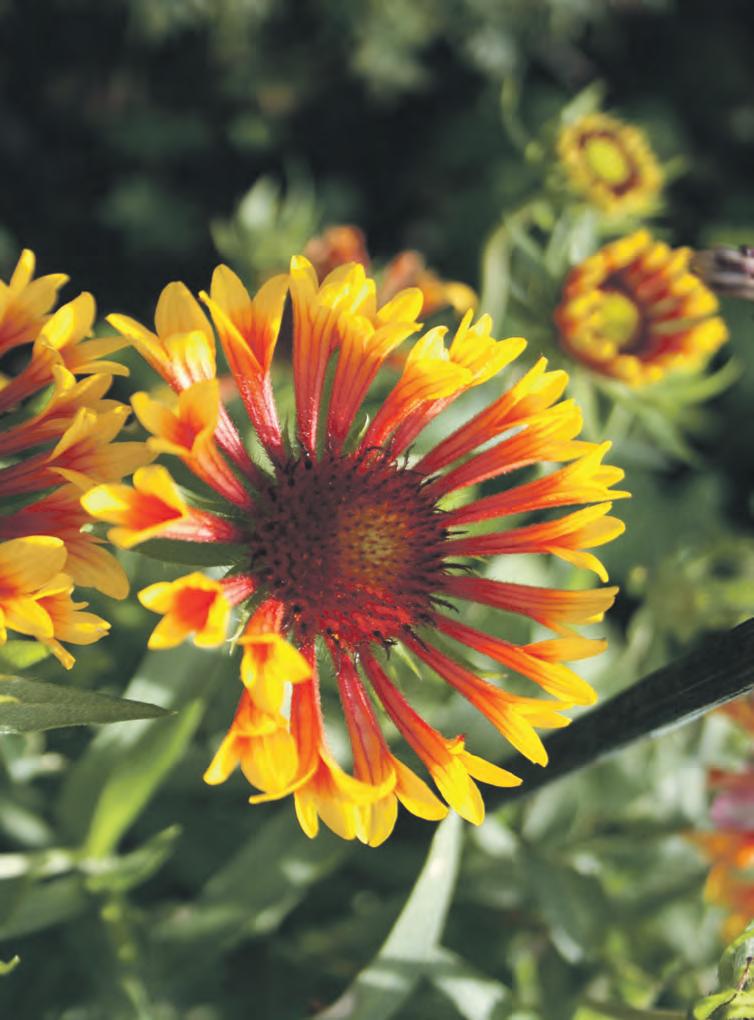
Open every day, Dogs welcome too... WELL WORTH A VISIT
Milton Abbot, Tavistock PL19 0PG Tel: 01822 870235
Since 1804 The Royal Horticultural Society (RHS) has endeavoured to lead the way in encouraging us, as a nation, to learn about and benefit from gardening.
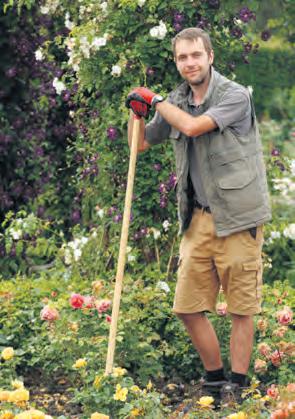
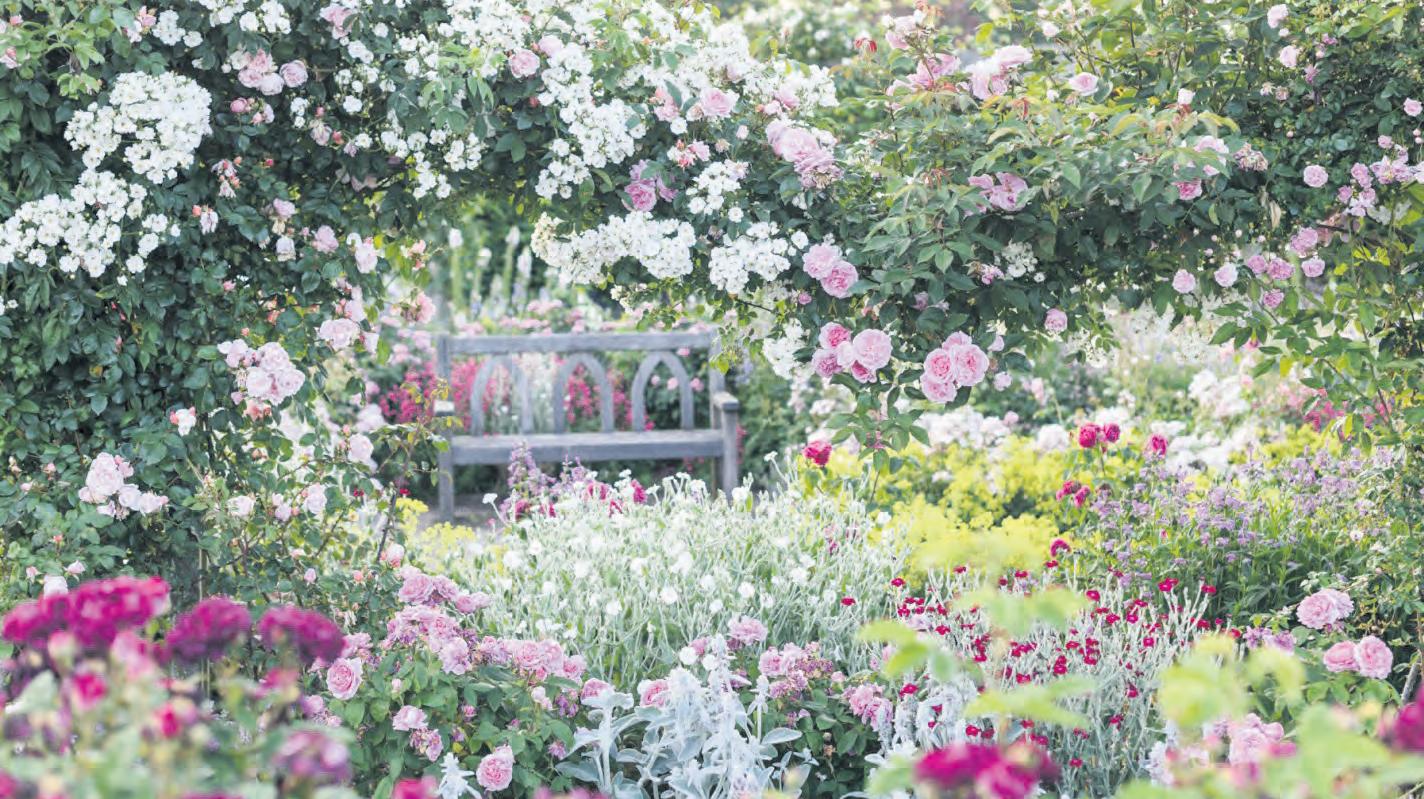
It believes that the opportunity to garden is fundamental to all of usthat plants and gardens help us to connect socially, improve our physical and mental health and benefit the planet.
RHS Rosemoor in Torrington in a north Devon valley blends formal and informal planting to magical effect but is also seen as a leading force of many aspects of gardening in the UK.
It was gifted to the RHS as an eight-acre garden by Lady Anne Berry in 1988 and now offers more than 65 acres of garden for visitors to explore. Rosemoor became home to Lady Anne and her mother following the death of her father, Sir Robert Horace Walpole, in 1931. Sir Robert had originally bought Rosemoor as a salmon fishing lodge. At that time the garden was, as Lady Anne described it, ‘dull and labour intensive, typically Victorian, with a great use of annuals in beds around the house.’ During the 1930s, Lady Anne’s mother created The Stone Garden, the first area of hard landscaping at Rosemoor, which still lies at the heart of the old garden.
The garden has moved gradually and powerfully from those early days to becoming a pioneer and is often quoted as a pioneer of these gardening standards, especially in terms of sustainability and education.


Alex Paines, one of the garden’s team of horticulturalists, explains that the drive to maintain these standards comes from all sides: “There is so much passion in the horticulture team. We spend all day gardening then in our spare time we talk about gardening and read books about gardening, we are so passionate.
“We are so dedicated to being the best, not just in terms of being the most attractive garden there is but doing it in the best way possible, and the most ethically and morally way possible.
“There is an excitement about new ideas that we can experiment with and that’s where a lot of the drive comes from. Now we have a new director and president of the RHS who are both very much on the same page so there is very much an approach from above and below pushing for these new ideas”.
Education is central to the charity’s long-term strategy, and Rosemoor’s education programme reflects this. Alex said: “We want to reach and educate as many people about horticulture. The RHS is really passionate that if children connect with gardening at an early age, even if they go through various stages as they get older, they are more likely to come back to it. So we have coach-loads of children coming to the garden - both primary and secondary.”
And the education programme for adults is as comprehensive, with courses from recreational - including gardening for wildlife and managing meadows - to professional horticulture training. Sustainability is now one of their biggest themes and
RHS Rosemoor is now more than an inspirational place for formal and informal plants and gardens. It works hard to set new gardening standards on education and sustainability.The eight acre gardens blend formal and informal planting to magical effect Alex Paines: “There is an excitement about new ideas”.
focuses - and one which the garden knows is of huge interest to their visitors. The RHS’ targets include being climate positive, zero waste to landfill, zero single-use plastic and water neutral by 2030, and biodiversity positive by 2025.
Alex said: “We are constantly working towards being more sustainable, the RHS has a sustainability strategy and as an organisation we also have several benchmarks we are working towards.
“Visitors are really interested in how they can be more sustainable and we want to help them. For example we compost all our green waste, we don’t remove leaf litter and we veterinise trees - this is where we leave increase the amount of dead areas within tree trunks to attract wildlife.”
“We have a substantial vegetable garden here and a lot of people are now interested in growing food, and food security and that ties in with what we do here - a lot of the produce from the gardens gets used in the restaurant and we also have an honesty table where we sell excess veg and anything that is too ugly for the public to see in the gardens.
“Gardeners judge themselves and their own gardens by what they see at places like Rosemoor so we are not just setting the standard but also showcasing what is ok - that it’s ok to make mistakes and it’s ok to not be so fussy about everything.”
Looking after wildlife is high on Rosemoor’s agenda, with projects including carrying out regular biodiversity surveys on birds, bats and hedgerows and installing new nest boxes as well as specialised boxes for kestrels and tawny owls.
They also create ‘dead hedges’ - a fence made from dead branches and natural materials which are havens for invertebrates.
Alex said: “Visitors are so interested in bees and butterflies, and especially meadows at the moment. People are now seeing lots of wild gardening around, and their local town councils leaving the grass long and want to understand why and how to do it.”
He explained that being transparent is very important: “We don’t want to hide anything from the public. For example we had quite a few of our shrubs die in the harsh winter but we didn’t hide it - a lot of visitors said it was quite comforting for them to know that and explore how we can deal with that in the future.
“And innovation comes from the challenges we experience here at Rosemoor - and we want gardeners to feel the same way. For example some of our trees had honey fungus and had to be taken down. It was too risky to replant them so instead we used the area to create a wild meadow. Couldn’t replant them because of the risk.
“We share these things with our visitors, saying what we’ve done and why we’ve done it - this is an experiment for us. A message to gardeners that things will go wrong and we have to learn to work with problems and issues.”

Unfortunately a gremlin was at work in the September crossword. The clues and answers are all correct but a rogue number has created mayhem! The final 5 Across clues 38,39,40,41 and 42 need their answers put in the grid one clue later. I apologise for this hiccup and hope that you can all finish the puzzle successfully - Saranda. The winning entry to be drawn by us will receive £100 of RHS gift tokens. Completed entries should be sent to Mount House, Halse, Taunton, Somerset TA4 3AD. Closing date is Friday 27th October. The winner of our September issue crossword was Rosanna Hancock, Exeter.
ACROSS
1. Green, leafy vegetable of the beetroot species (5,5)
7. French girl’s name and tall plant with white and yellow flowers (10)
12. Shrub of the rose family, Spiraea prunifolia (6,6)
13. Pouring out wine in honour of a god (8)
14. Genus of cacti including 33 species from South America (6)
15. Iconic national symbol of New Zealand (6,4,4)
16. A swelling at the base of the sporangium in some mosses (9)
17. Formerly worn on the head by clergymen (6,3)
21. Member of the mint family, lemon balm (7)
22. Like a trumpet vine? (13)
25. Monotropa uniflora or ghost plant (6,4)
28. Take the wrong course in life (4,3,3)
29. Garden pest particularly fond of a certain vegetable (6,4,3)
30. Collects plants or fruit for food (7)
34. A pile of refuse material from an excavation (5,4)
36. Smelling of mildew or decay (9)
39. A painful weed, Urtica dioica (8,6)
41. Contemplation (6)
42. Part of a plant’s ovary wall (8)
43. Common North American climber (7,5)
44. Langurs of southern Asia (10)
45. Time of the year around beginning of August (10)
DOWN
2. Shakespeare added saffron to colour this fruit dish (6,3)
3. Lilies of the Field star who died in 2022 (6,7)
4. Peruvian shrubs cultivated for their medicinal bark (9)
5. Relating to the country (8)
6. Adjective that best describes Atropa belladonna (6)
7. Common name for several plants in New Zealand (5)
8. The state of being relative (12)
9. Insect that carries bits of leaves over its back when foraging (8,3)
10. Liqueur flavoured with almonds or peach kernels (7)
11. Treeless Arctic region of Europe, Asia and North America (6)
18. Capital city of Hawaii (8)
19. Genus of plants known as bleeding-hearts (8)
20. Genus of strongly scented subshrubs commonly called rue (4)
23. Beaucarnea recurvata or ponytail palm (9,4)
24. Phleum pratense or meadow cat’s-tail (7,5)
26. Biblical man of the soil and vineyard planter (4)
27. Containing a food substance your body can use (11)
31. Genus of plants including mugwort and wormwood (9)
32. Common name of plant in species Silphium integrifolium (9)
33. Chemical element Lu with atomic number 71 (8)
35. Any loose, diversely branching flower cluster (7)
37. A creeping plant stem that takes root at points along its length (6)
38. Any of a group of naturally occurring unsaturated alcohols (6)
40. King of rock and roll (5)
Answers from previous issue, September 2023:
“Sustainability is now one of their biggest themes and focuses... the targets include being climate positive, zero waste to landfill, zero single-use plastic and water neutral by 2030, and biodiversity positive by 2025.”
“We are constantly working towards being more sustainable”.
ACCOMMODATION
Churchwood Valley
Secluded cosy cabins & lodges in wooded valley running down to Wembury Bay & SW Coastal Path

Plymouth, Dartmoor & lovely South Devon Villages & Towns in easy reach. Pets Welcome. Forest School. Tel: 01752 862382 www.churchwoodvalley.com
Carmarthen Bay South Wales
Seafront chalet situated on estuary.

Sleeps up to 6. Seaview. Well Behaved Dogs Welcome Free of Charge. Free WIFI. Open from 1st March - 31st Dec. For Brochure
Tel: 01269 862191
GLORIOUS NORTH DEVON. Only 9 cosy caravans on peaceful farm. Wonderful walks in woods & meadows. Easy reach sea, moors & lovely days out. £125-395pw. Discount couples. Nice pets welcome. 01769 540366 www.snapdown.co.uk
BOSWORLAS NEAR SENNEN/ST
JUST, CORNWALL. Cosy Cottage, rural views, Sleeps 2-4 01736 788709 www.bosworlas.co.uk

ACCOMMODATION HOLIDAY COTTAGES

Peace, Privacy, and Stunning
Views!
4* Delightful cosy cabin for 2, nestling between Wye and Usk Valleys. Shirenewton village & pubs close by. Wonderful walks, splendid castles, bustling market towns. Perfect for all seasons!
Tel: 01291 641826
Email: lynne@bryncosyn.co.uk www.bryncosyn.co.uk
WYE VALLEY/FOREST OF DEAN. Fully equipped single-storey cottage with two en-suite bedrooms. Wi-fi.Recently awarded Visit England 4-star GOLD. Rural retreat, shops/pubs one mile. Enquiries welcome. Tel: 01594 833259 www.cowshedcottage.co.uk
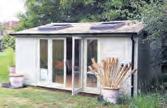


GARDEN PLANTS/ACCESSORIES


Penrice Castle Gower
16 holiday cottages on an 18th century Estate on the Gower Peninsula with beautiful Grade I listed historic park and gardens.
Tel: 01792 391212
SEED SUPPLIERS
Near Stratford-upon-Avon
Lovely self-catering cottage in peaceful location: large garden.
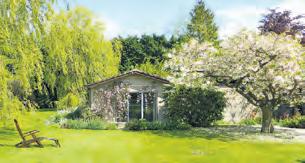
Sleeps 2. Perfect for famous gardens, NT properties & Cotswolds.
Tel: 01789 740360
www.romanacres.com
NORTH DEVON NEAR CLOVELLY. 3 delightful cottages situated in 12 acres of idyllic countryside. Sleeps 2-4. 1 Wheelchair friendly. Brochure: 01237 431324 www.foxwoodlodge.co.uk foxwoodlodge@outlook.com
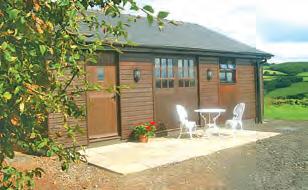
CARDS, PRINTS & GIFTS
A range of over 200 greetings cards and prints from the flower paintings of ANNE COTTERILL

We sell to both individuals and trade. No order too small. Contact us for your free catalogue.

Mill House Fine Art Publishing, Bellflower Gallery, Market Place, Colyton, Devon EX24 6JS Tel. 01297 553100 info@millhousefineart.com www.millhousefineart.com
GARDEN BUILDINGS

www.penricecastle.co.uk Looking
GARDEN SERVICES
SPECIALIST GARDEN PRODUCTS





POLYTUNNELS

SPECIALIST NURSERIES
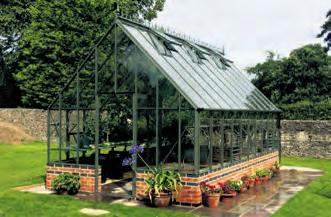
The autumn is a time when gardeners are spending proper time and effort preparing next year’s perfect crop of potatoes

As this suggests, first early potatoes are those varieties which can be planted and harvested first -plant out from end of February and harvest from June. These are ‘new’ potatoes, harvested while the tubers are still small. They take ten to 12 weeks, and they are good for growing in containers and bags.
Next ten issues, never miss out
Just £20 for a respected, knowledgeable and inspirational gardening magazine
The subscription costs just £20 and guarantees a ten times a year magazine packed with information, gardening advice, local events.
It may be that you are still harvesting your crop of home-grown potatoes but a recent survey on the most successful crops has suggested it is in the autumn where most of the secrets in great potato growing lie. Growing spuds has become an all year-round occupation!
So no sooner has one crop come out of the ground, preparing the soil, choosing, buying and chitting tubers and getting a really early start in the are all included in what needs to be done.
For instance, it is best to prepare your planting area well in advance of planting your potatoes - preferably in October or December, so the soil has a chance to settle.
Turn over the soil to loosen it, removing any weeds or large stones, and while you’re at it, incorporate plenty of well-rotted organic matter.
Selecting the right variety for your soil is also important and may need some research.
Potato plants, like all root vegetables, need to gather a lot of energy and store it to grow large and tasty tubers. Potatoes take a lot of nutrients from the soil – nitrogen, potassium, phosphorus. Potatoes prefer a slightly acidic environment but can tolerate most soil types. These hungry plants will exhaust your soil, so don’t plant potatoes in the same place next year!
Potatoes are cool weather crops, which means they like to do most of their growth outside of the high heat of summer. Potatoes, therefore, are most planted in the early spring, a few weeks before the frosts have passed.
Like first earlies, second early potatoes are eaten as ‘new’ or salad potatoes and don’t store very well but take a few more weeks to mature than the first early varieties - about 14-16 weeks. These are also a good choice for growing in containers and growing bags. Some second early potatoes can be grown for ‘Second Cropping’, which means they can be planted in August for harvesting at Christmas time. These will need frost protection and are best grown in bags in a greenhouse. There is no need to chit these potatoes, as the ground is already warm enough to speed them along their way.
Maincrop potatoes are those like your common baked potato and mash spuds. They store well and you can eat them months after harvest. The plants and their tubers are much larger than first and second early potatoes and as such take longer to mature at about 15-20 weeks.

It is the practice of letting tubers sprout prior to planting. Well chitted potatoes will lead to stronger plants once in the ground. It also allows you to identify any potatoes that fail to develop so they can be discarded before planting.
Regardless of buying seed potatoes or choosing from your own stock, chitting is strongly encouraged. Around six weeks before planting out, place your seed potatoes on a bright windowsill or in the greenhouse with the eyes pointing up.
Potato Blight – a fungal disease which turns leaves yellow/brown and can result in rotting tubers. Often occurs in excessive humidity – too wet and too warm. There is no complete remedy for potato blight. Cut away affected leaves where possible but cutting back too much will prevent good tuber growth.
Green Potatoes - potatoes turn green when exposed to sunlight. These are poisonous if ingested. This is easily avoided by keeping covered by mounding up while in the earth and storing in darkness once harvested.
Common Scab - a soil-borne disease that is often left undetected until harvest times arrives. It presents as dark murky lesions on the skin of the potatoes. The bacteria that cause scabby potatoes can remain in the soil for a long time, living off decaying plant matter, so remove as much as you can once harvested. Crop rotation will aid prevention in future crops.
Potato Rot - a common problem with homegrown potatoes that can occur during and after lifting due to wet conditions. Avoid over-watering during maturation and ensure potatoes are dry before storage.
You can select from one of our five editions of the magazine which is relevant to where you live.
Subscribing is simple.
Just fill in the form below and include your cheque for £20.
I would like to subscribe to Country Gardener for the next ten issues for £20:
This is a subscription just for me *
This is a gift (send next available issue) *
Please choose your region by ticking the box:
Cotswolds * Devon * Dorset * Somerset * Hampshire *
Your details: Title
to
send to:
Remember to tell us which one of the five editions you would like to receive.
Growing perfect potatoes is an all year round taskAny experienced gardener will tell you that autumn is nature’s time for planting. That’s not just a ploy to get you out there. The soil is warm and moist; newly planted trees and shrubs have got all winter to get their roots out into the ground, to establish before they must cope with supporting leaves and flowers next summer. Chances are, if you plant now you will have less aftercare to administer next season. Preparing the soil is easier too. Digging is a pleasure in autumn and after some rainfall, it’s not as arduous.
Here are five popular choices which will add dramatic colour to your autumn garden.


Japanese maples are easy to grow in containers or in the ground, with most preferring a sheltered, shady spot. Small and slow growing with a graceful habit and beautiful foliage, they're the perfect choice for even the tiniest of gardens.

The varieties of Acer palmatum are some of the finest shrubs or small trees for autumn colour. Choose a purple-leaved variety like ‘Bloodgood’ or ‘Fireglow’. These give you colourful foliage through spring and summer and a splendid show in autumn. They don’t need acid soil and they do need full sun. They don’t like to be too dry at the roots. They are a great choice for pots, so ideal for small gardens.
Berberis thunbergii, commonly called Japanese barberry, is a spiny, broad-rounded, deciduous shrub with obovate green leaves. It typically matures to five feet tall and as wide. Lovely arching stems of wine red leaves suffused with salmon pink at the tips of the shoots. A great mixer with other shrubs and perennials in summer, then ablaze in autumn as the leaves turn to scarlet.
Cotinus is famously known as the ‘smoke bush’, for its hazy plumes of soft pink, summer flowers that really do resemble clouds of soft smoke. However, it’s the ovalshaped foliage of these shrubs that makes a dramatic statement. There's a range of cultivars with leaf colour ranging from apple green through to purple, and they all share characteristically brilliant autumn colouring, with a fiery display of yellow, red and deep scarlet. Smoke bushes are mostly quite large shrubs or small trees, many reaching around four metres by four metres , but there are smaller cultivars available.
Cotinus are big growers, so they are shrubs for the back of the border, but you can restrict their size by pruning. The crimson autumn colour is a bonus; just when you thought it couldn’t get any better.

A British native, very upright suckering shrub, with good autumn colour and reddish stems in winter, You may think of red-barked dogwoods as the shrubs you grow for their winter stems, or for their colourful variegated leaves. Cornus alba ‘Sibirica Variegata’ has both, and it doesn’t get too big either. However, its best feature is the amazing crimson-pink autumn colour that spreads through those pretty green and white variegated leaves.
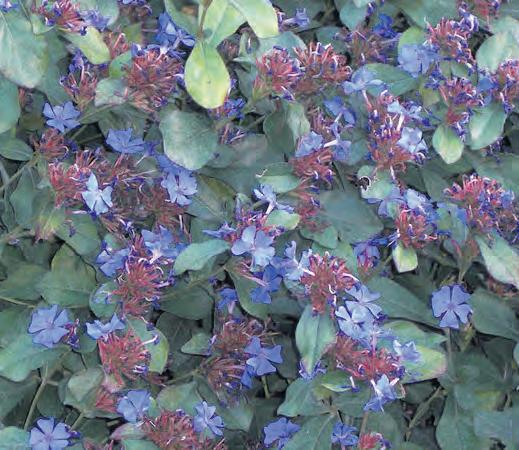
The hardy plumbago, Ceratostigma plumbaginoides, is a low-growing, spreading, woody perennial with slender red stems clothed in bright green leaves, which turn bright red before falling in autumn. However, it's grown mainly for its vivid blue flowers, which appear in small clusters from late summer to mid-autumn. It makes a great ground cover plant and is perfect for adding late colour to the front of the border. It develops tolerance to drought when established. Ceratostigma willmottianum is a small twiggy shrub with dark green pointed leaves. Planted in a sunny spot, the leaves tint with flame and gold as autumn progresses, a lovely combination with the sapphire blue flowers, which are freely produced until the first hard frosts. Late butterflies love it as a source of nectar.
1. Whatever you are planting, a tree, bush or shrub , always water it thoroughly before you take it out of its pot. Dig a hole that’s deep enough and wide enough to accommodate the rootball with plenty of space all around it.
2. Make sure you break up the soil in the bottom of the planting hole with a fork.
3. Add a slow release general fertiliser to the soil as you backfill around the rootball.
4. Firm the soil around the roots and water your new plant thoroughly. If you get your levels right, leaving a shallow saucer shaped depression around the plant really helps to direct rainfall into the roots; it is easier when you water too.
Editorial Publisher & Editor: Alan Lewis alan@countrygardener.co.uk
Tel: 01823 431767
Time Off Kate Lewis timeoff@countrygardener.co.uk
Advertising Sales Ava Bench - Somerset & Hampshire ava@countrygardener.co.uk
Tel: 01278 786139
Cath Pettyfer - Devon cath.pettyfer@countrygardener.co.uk
Tel: 01837 82660
Corina Reay - Cotswolds & Dorset corina@countrygardener.co.uk Tel: 01823 410098

Classifieds classified@countrygardener.co.uk
Design & Production Aidan Gill aidan@countrygardener.co.uk
Gemma Stringer gemma@countrygardener.co.uk
Distribution & Stockists
Pat Eade distribution@countrygardener.co.uk
Accounts and subscriptions
Heather Rose heather@countrygardener.co.uk
may be reproduced, stored or made available in any form, without the written permission of the copyright holder and Publisher, application for which should be made to
Publisher.
material: do not send or submit your only version of manuscripts and/or photographs/transparencies to us as these cannot be returned to you. While every care is taken to ensure that material submitted is priced accurately and completely, we cannot be responsible or liable for any loss or damage suffered. Views and/or opinions expressed in this publication do not necessarily represent those of Country Gardener or the Publisher. Printed by Mortons Print Ltd, Morton Way, Boston Road Industrial Estate, Horncastle, LN9 6JR.
October is nature’s time for planting and there’s a wonderful selection to be made of dramatic autumn colours





